PULSAR FORWARD FN455S Manual
Specifications
| Model | FN455S |
| SKU | 78199 |
| Optical Characteristics | |
| Lens focus, mm | 50 |
| Relative aperture, D/f | 1:1 |
| Field-of-view (Horizontal), ° | 6.3 |
| Field-of-view (Horizontal), m per 100 m | 11 |
| Detection Range (animal height 1.7 m), m/y | 500/546.8 |
| Minimum Focusing Distance, m/y | 5 |
| Recommended daylight optics magnification, x | 2-8 |
| Electronic Specifications | |
| Sensor type / resolution | CMOS HD 1280X720 |
| Display type / resolution | AMOLED 1746×1000 |
| Detachable IR Illuminator | |
| Type / wavelength, nm | LED 940 |
| Operational Characteristics | |
| Power Supply, V | 3.1-4.2 |
| Battery type / Capacity / Rated Output Voltage | Li-Ion Battery Pack IPS7 / 6400 mAh / DC 3.7 V |
| External Power Supply | Micro USB type B (5V) |
| Max. Battery Pack Life at t = 22 °C (Wi-Fi off, IR off), Hour | 9 |
| Degree of protection IP code (IEC60529) | IPX7 |
| Operating temperature, °C | -25 – +50 |
| Overall Dimensions (with battery and monocular), mm/inch |
273х136х77 / 10.75×5.35×3.03 |
| Weight (with battery and monocular), kg/oz | 1 / 35.3 |
| Video Recorder | |
| Video/Photo Format | .mp4 / .jpg |
| Built-in Memory | 16 GB |
| Wi-Fi Channel* | |
| Frequency | 2.4 GHz |
| Standard | 802.11 b/g |
| Bluetooth | |
| Wireless Protocol | BLE 4.2 |
*Reception range may vary depending on various factors: the presence of obstacles, other Wi-Fi networks.
About the device
Description
The Forward FN455S digital night vision device is designed for various areas of application, including hunting surveillance, security activities, night photography and video recording.
The digital module included in the Forward FN455S package can be mounted on lenses of various daytime optical instruments using special adapters, enabling them to be used for night-time observation.
To get started, see the sections:
Installing Digital Module on the Optical Device
Package Contents
- Digital module
- Pulsar 5×30 Monocular
- Carrying Case
- Wireless Remote Control
- IPS7 Battery Pack
- Battery Pack Charger
- Power Adapter
- USB Cable
- Quick Start Guide
- Lens-Cleaning Cloth
- Warranty Card
- Neck strap
Features
- 1280X720 HD sensor
- Enhanced night-time sensitivity
- Simple transformation of a daytime optical device into night device.
- Preserves the benefits of daytime optics in night-time conditions
- Comfortable use in a wide range of daytime optical magnifications
- Invisible long-range IR Illuminator
- SumLight™ enhanced sensitivity firmware
- Detection distance of up to 500m
- Instant power up
- Built-in video
- Power from quick-release, high-capacity B-pack rechargeable batteries
- Four-point mounting system with automatic clamp
- Wireless remote control
- Wi-Fi integration with iOS and Android devices
- Remote firmware updates
- Fully waterproof (IPX7)
- Extreme operating temperature range (-25 °C – +50 °C / -13 °F – +122 °F)
- MicroUSB Power Bank charging
- Storing photos and videos in Cloud when using the Stream Vision 2 App
Components and Controls
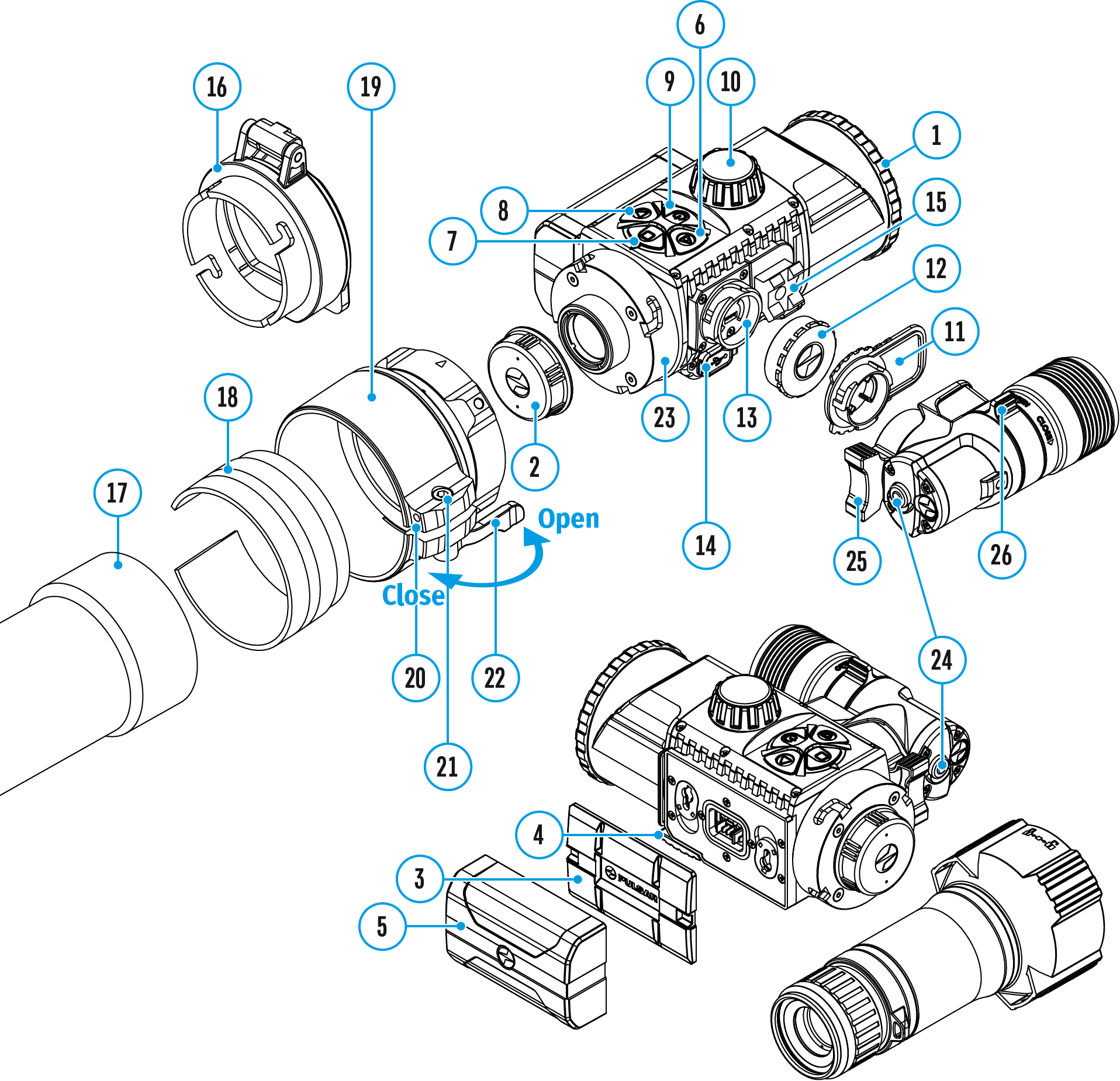
- Lens cover
- Eyepiece cover
- Battery compartment cover
- Battery locking lever
- Battery pack
- RIGHT button
- M (MENU) button
- LEFT button
- ON/OFF button
- Lens focus knob
- IR illuminator cover
- IR illuminator connector cap
- Connector for installing IR illuminator
- MicroUSB port
- Weaver rail
- Adapter cover*
- Optical device lens
- Insert*
- Adapter*
- Tightening screw*
- Screw*
- Adapter lever*
- Mounting area
- IR button
- IR illuminator arm
- IR illuminator lens lock knob
*Items of Cover Ring Adapter FN (available separately)
Button Operation
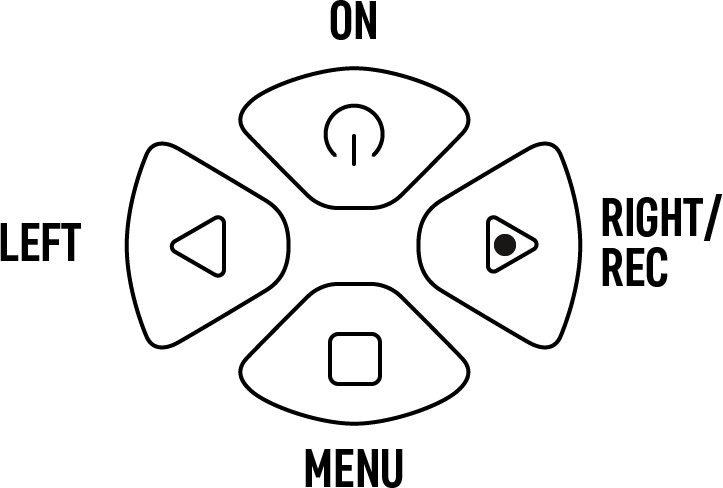
| Operation | Button |
| Power device on | |
| Power device off | |
| Turn display off | |
| Turn display on | |
| Turn on/off SumLight™ | |
| Turn on/off Wi-Fi | |
| Video Recorder | Button |
| Start/pause/resume video recording | |
| Stop video recording | |
| Switch to video/photo mode | |
| Capture Photo | |
| Main Menu | Button |
| Enter main menu | |
| Navigation downwards/counterclockwise | |
| Navigation upwards/clockwise | |
| Confirm value | |
| Exit submenu without confirming selection | |
| Exit main menu | |
| Quick Menu | Button |
| Enter quick menu | |
| Switch between quick menu options | |
| Increase value | |
| Reduce value | |
| Exit quick menu |
Getting started
Removing the IR Illuminator
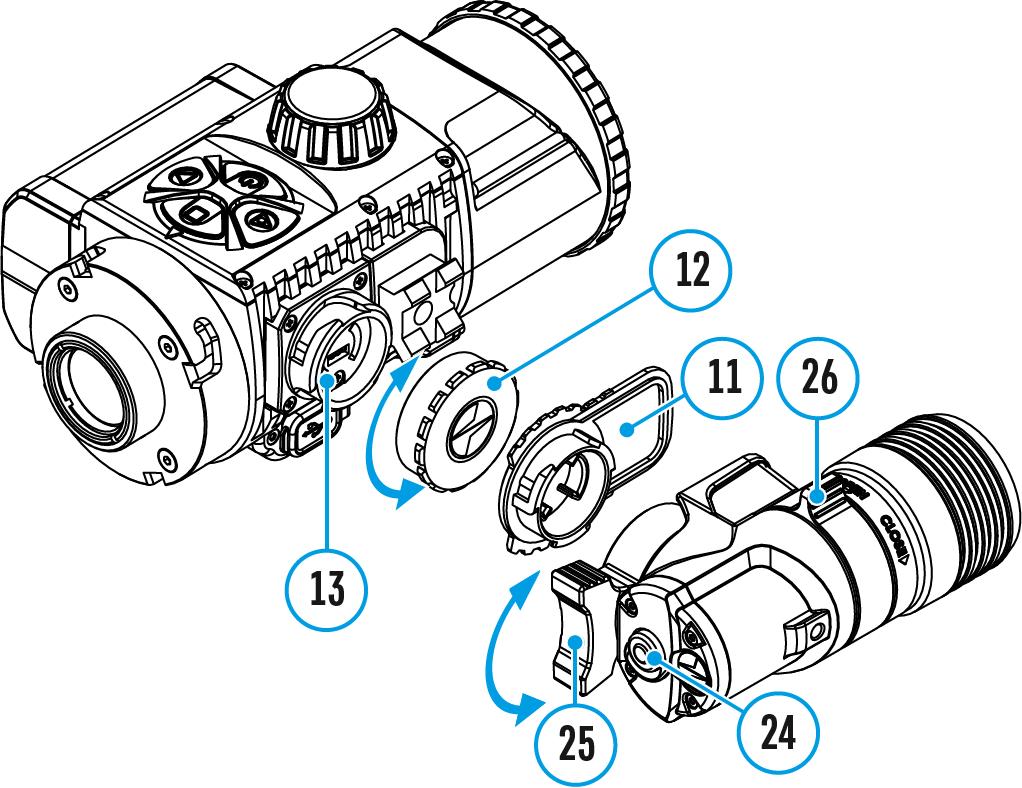
- Raise the lever (25).
- Disconnect the IR illuminator from the device.
- Install the cap (12) on the connector for installing the IR illuminator (13).
- Put the cover (11) on the IR illuminator.
Installing the IR Illuminator
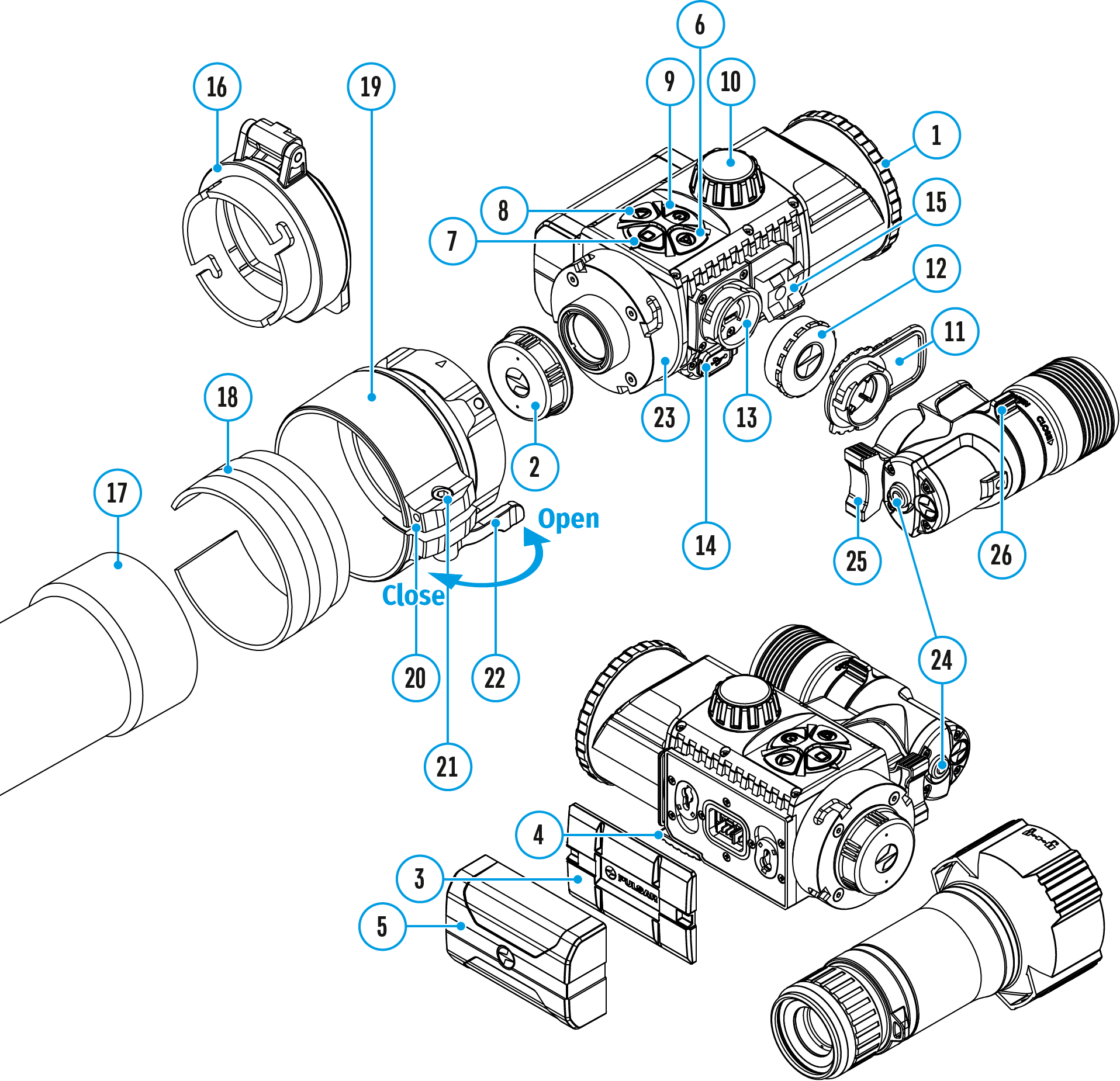
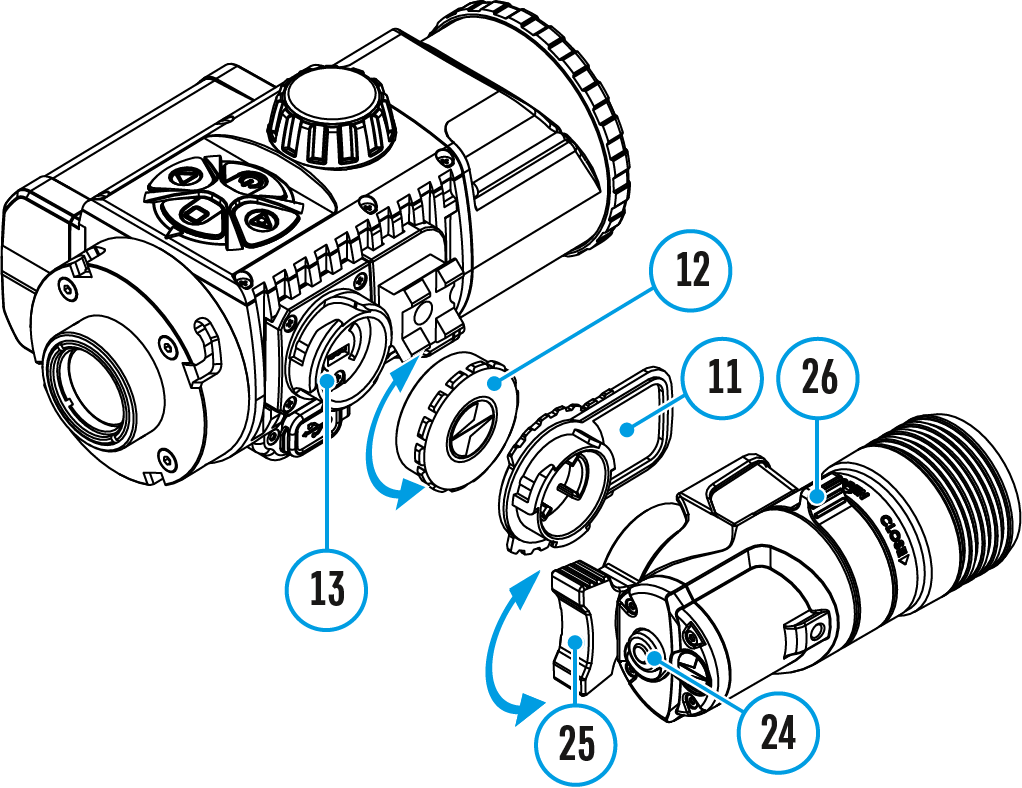
Step 1. Install the IR illuminator
- Remove the cap (12) from the connector to attach the IR illuminator (13).
- Remove the cover (11) from the IR illuminator.
- Install the IR illuminator on the connector (13). The lever (25) should be in the up position.
- Lock the IR illuminator by pressing the lever (25) down.
- Make sure that the IR illuminator is mounted and connected to the device.
Step 2. Turn on the IR illuminator
- Turn on the device using the ON/OFF (9) button to activate the IR illuminator.
- The status bar will display the disabled illuminator icon
 if the IR illuminator is not connected. This icon is not displayed when the IR illuminator is connected.
if the IR illuminator is not connected. This icon is not displayed when the IR illuminator is connected.
Step. 3. Adjust the power level of the IR illuminator
- Briefly press the IR (24) button at the end of the illuminator. The power level when switching on is minimum
 .
. - The IR illuminator icon will be displayed on the status bar with the relevant power level.
- Successive brief presses of the IR (24) button will toggle the brightness level of the illuminator (
 >
>  >
>  >
> ).
).
Step 4. Adjust the position of the light spot
- To adjust the position of the light spot in the field of view of the device, turn the IR-illuminator lens lock knob (26) to the OPEN position.
- By moving the lens of the IR illuminator with your hand, adjust the required position of the light spot in the field of view of your device. After successful adjustment, turn the lock knob (26) in the CLOSE direction while aiming the lens in the desired direction to lock the IR illuminator lens.
Step 5. Turn off the IR illuminator
- The IR illuminator is turned off by a long press of the IR (24) button.
- The IR icon will disappear from the screen.
Operating Features
The Forward FN455S device is designed for long-term use. Please follow these guidelines to ensure long life and maximum performance:
- Before using the attachment make sure you mount it according to the instructions in the Installing Digital Module on the Optical Device and Installing Pulsar 5×30 Monocular on to the Digital Module sections.
- Power off the device after use.
- Do not repair or dismantle an attachment under guarantee by yourself!
- The device can be used over a wide range of temperatures. If the device has been operated in the cold and brought into a warm room, do not remove it from its carrying case for at least 2-3 hours; this will prevent condensation forming on the external optical elements.
- Inspect and maintain the device regularly to ensure trouble-free operation and to avert and eliminate the cases of premature wear and tear and failure of components.
Installing Digital Module on the Optical Device
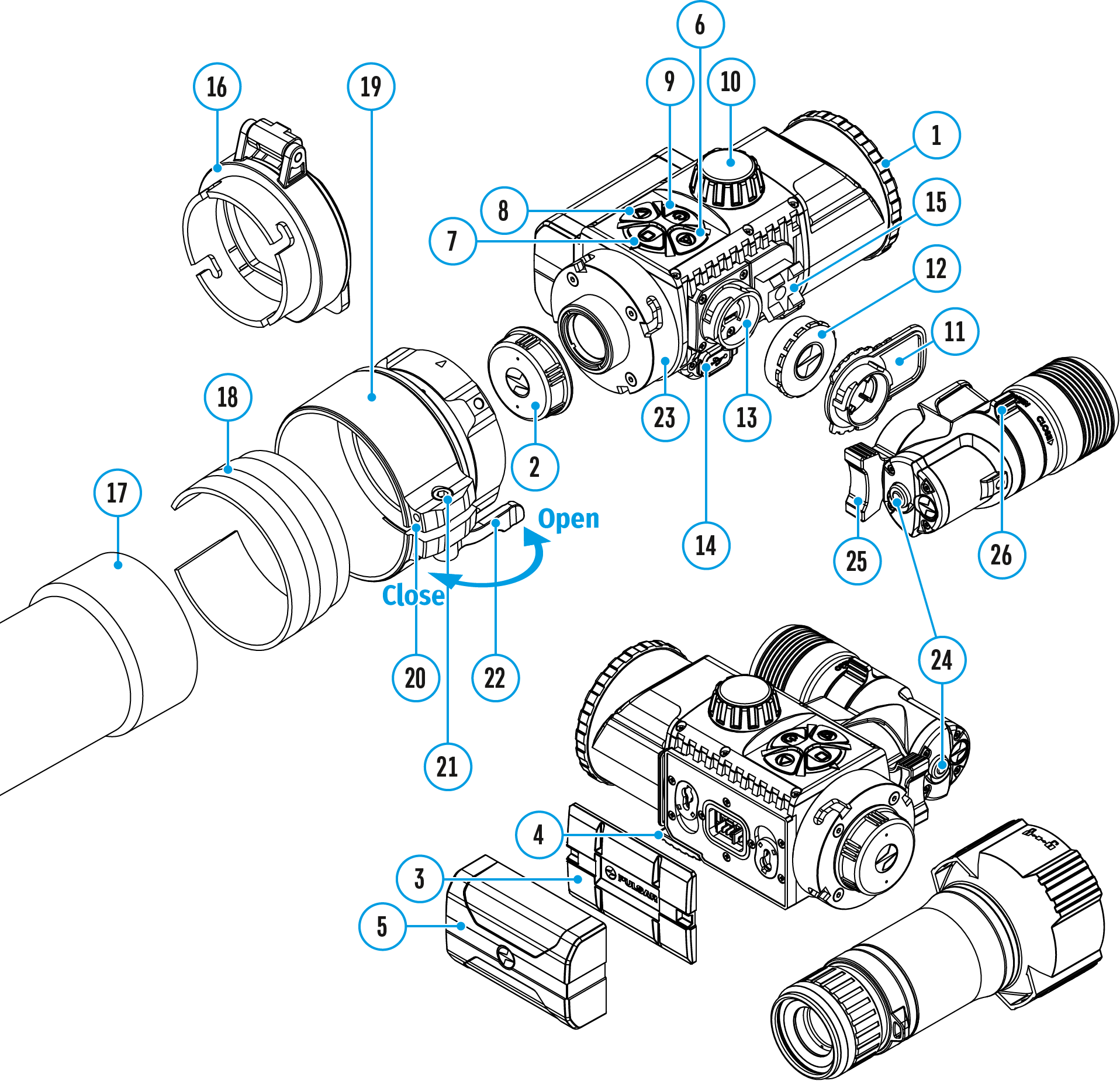
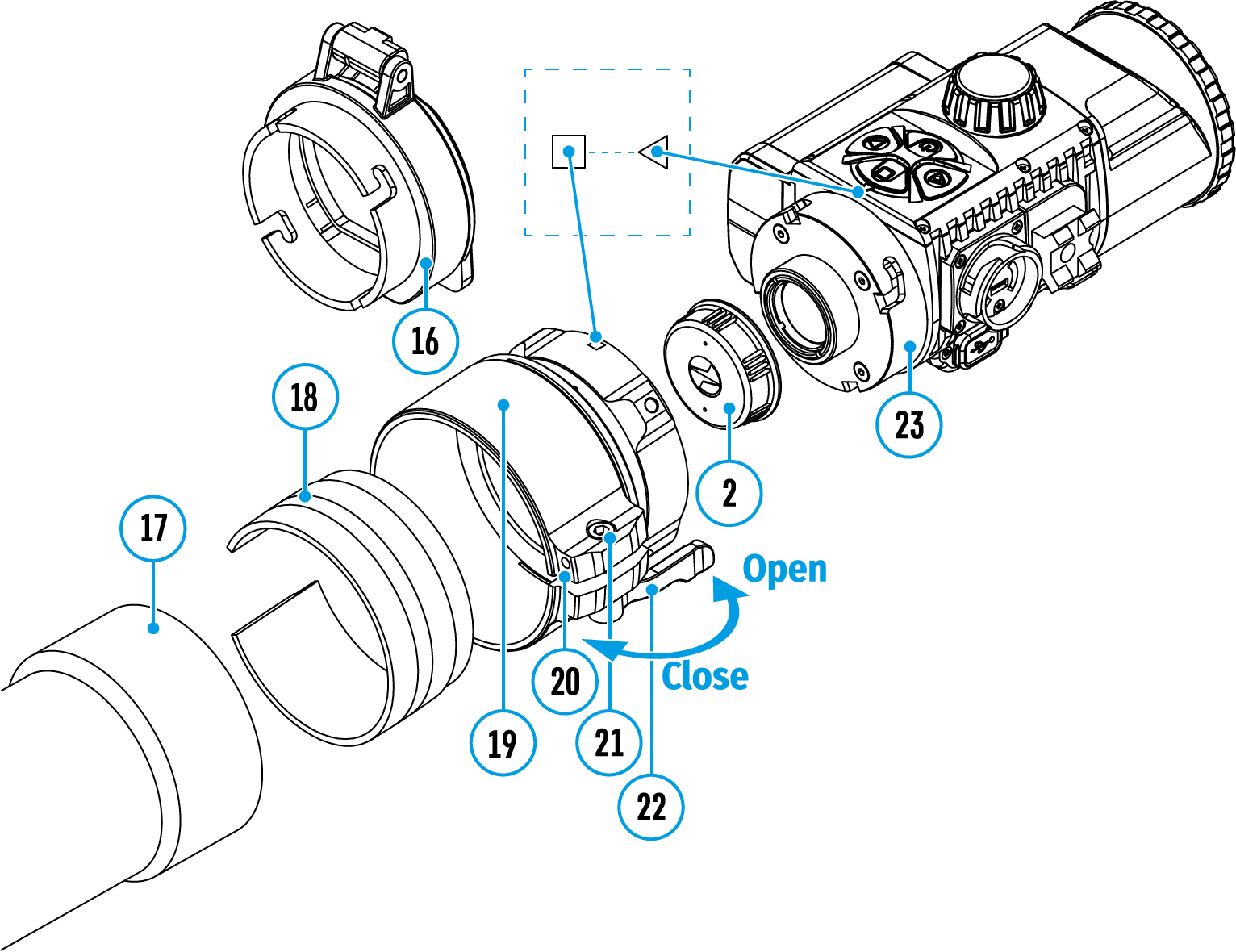
1. Select the adapter (available separately) with the required diameter of insert depending on the outer diameter of the lens of your optical device (see the Table).
2. The designation 42mm / 50mm / 56mm in the title of the adapter refers to the optical diameter of the lens in the optical device.
3. Remove the cap (16) from the 42mm adapter (19) (SKU 79171) by turning it clockwise. To remove the cap from the 50mm (SKU 79172) or 56mm (SKU 79173) adapters, turn it anticlockwise.
4. Degreasing of the body of the optical device before mounting is recommended.
5. Mount the insert (18) onto the adapter (19) as far as it will go.
6. Move the lever (22) to the OPEN position.
7. Mount the adapter with the insert into the lens of the optical device (17).
8. Move the lever (22) from its initial OPEN position to the CLOSE position.
9. Ensure that the adapter fits snugly against the lens.
10. If there is any gap, do the following:
- Loosen the locking screw (20) with an Allen key (S=2mm).
- Tighten the screw (21) with an Allen key (S=4mm) with the force necessary to ensure that the adapter fits tightly against the lens. The clamping forces should be 1 Nm.
- Tighten the locking screw (20).
11. The effort can be tested with a torque screwdriver.
12. Insert the digital module firmly into the adapter so that the pins located in the adapter case fit into the grooves (23) of the digital module. Turn the digital module clockwise as far as it will go. The triangular mark on the digital module and the square on the adapter body must be aligned.
13. To align the digital module, turn the handle (22) to the OPEN position and align the digital module with the horizon.
Selection table for optical device insert rings
| Cover adapter model |
The internal diameter of the insert needs to match the outer diameter of the objective lens housing of the daylight optical device it is being installed on. | |
| Insert internal diameter, mm | Suitable for lens housing of daylight optical devices with an outer diameter of, mm | |
| Cover adapter FN 42mm | 45.5 | 45.5 |
| 46 | 46 | |
| 46.5 | 46.5 | |
| 47 | 46.7-47.6 | |
| 48 | 47.7-46.7 | |
| 49 | 48.7-49.6 | |
| 50 | 49.7-50.6 | |
| Cover adapter FN 50mm | 51.6 | 51.6 |
| 53.4 | 53.4 | |
| 55 | 54.7-55.6 | |
| 56 | 55.7-56.6 | |
| 57 | 56.7-57.6 | |
| 58 | 57.7-58.6 | |
| 59 | 58.7-59.6 | |
| Cover adapter FN 56mm | 60 | 59.7-60.6 |
| 61 | 60.7-61.6 | |
| 62 | 61.7-62.6 | |
| 63 | 62.7-63.6 | |
| 64 | 63.7-64.6 | |
| 65 | 64.7-65.6 | |
Installing Pulsar 5×30 Monocular on to the Digital Module
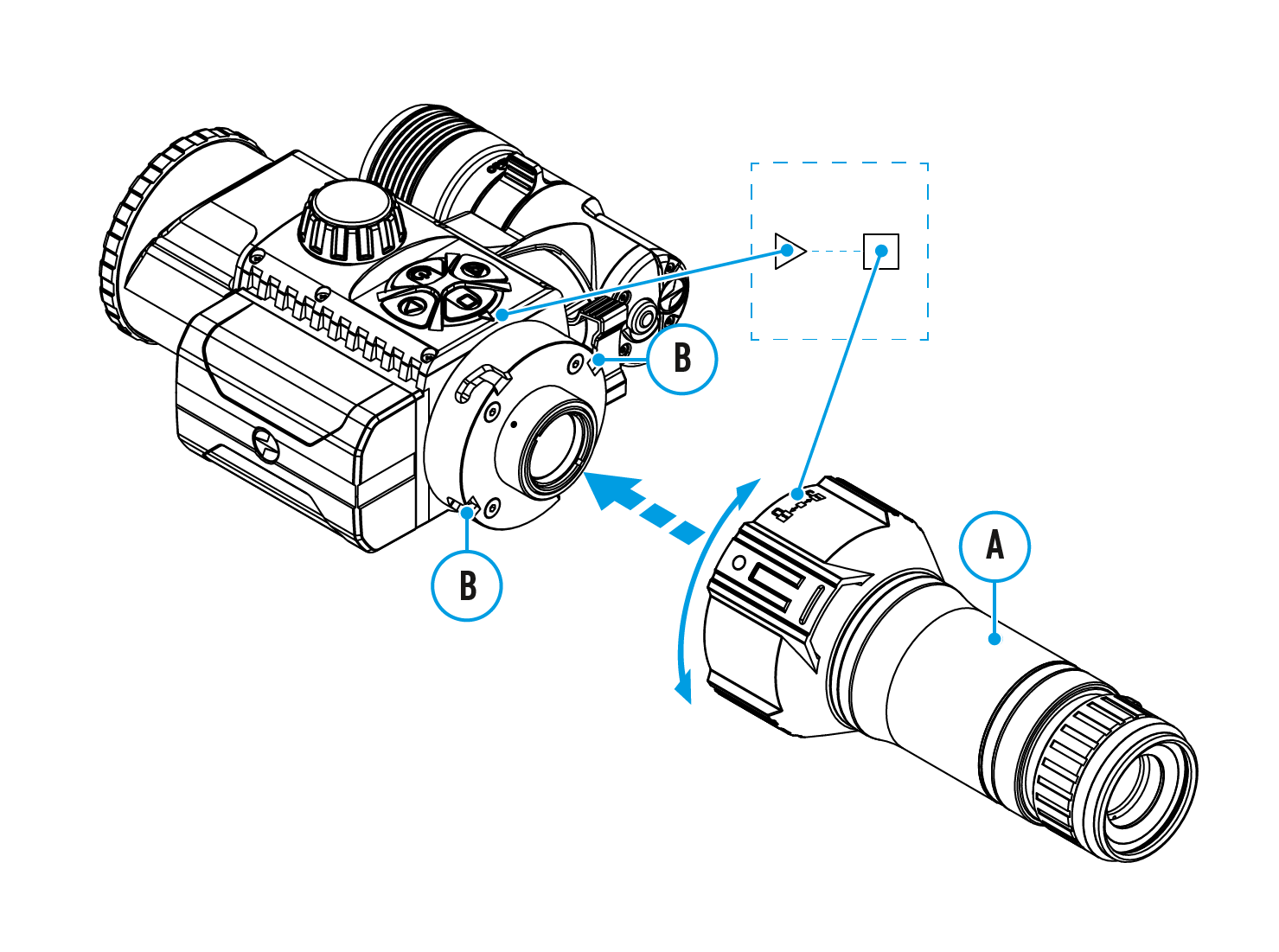
The Pulsar 5×30 monocular (included in the package) enables you to transform a digital module into a digital vision device for night-time observation with a magnification of 5x.
- Insert the monocular tightly into the digital module as far as it will go so that the pins on the monocular body (A) fit into the slots (B) of the digital module (see Fig.).
- Turn the monocular anticlockwise so that the monocular is fixed onto the digital module. The triangular mark on the digital module and the square on the monocular body must be aligned.
- To remove the monocular, turn it clockwise and gently pull it towards you.
Note: the neck strap (included in the delivery package) can be used with the monocular.
Powering on and Image Settings
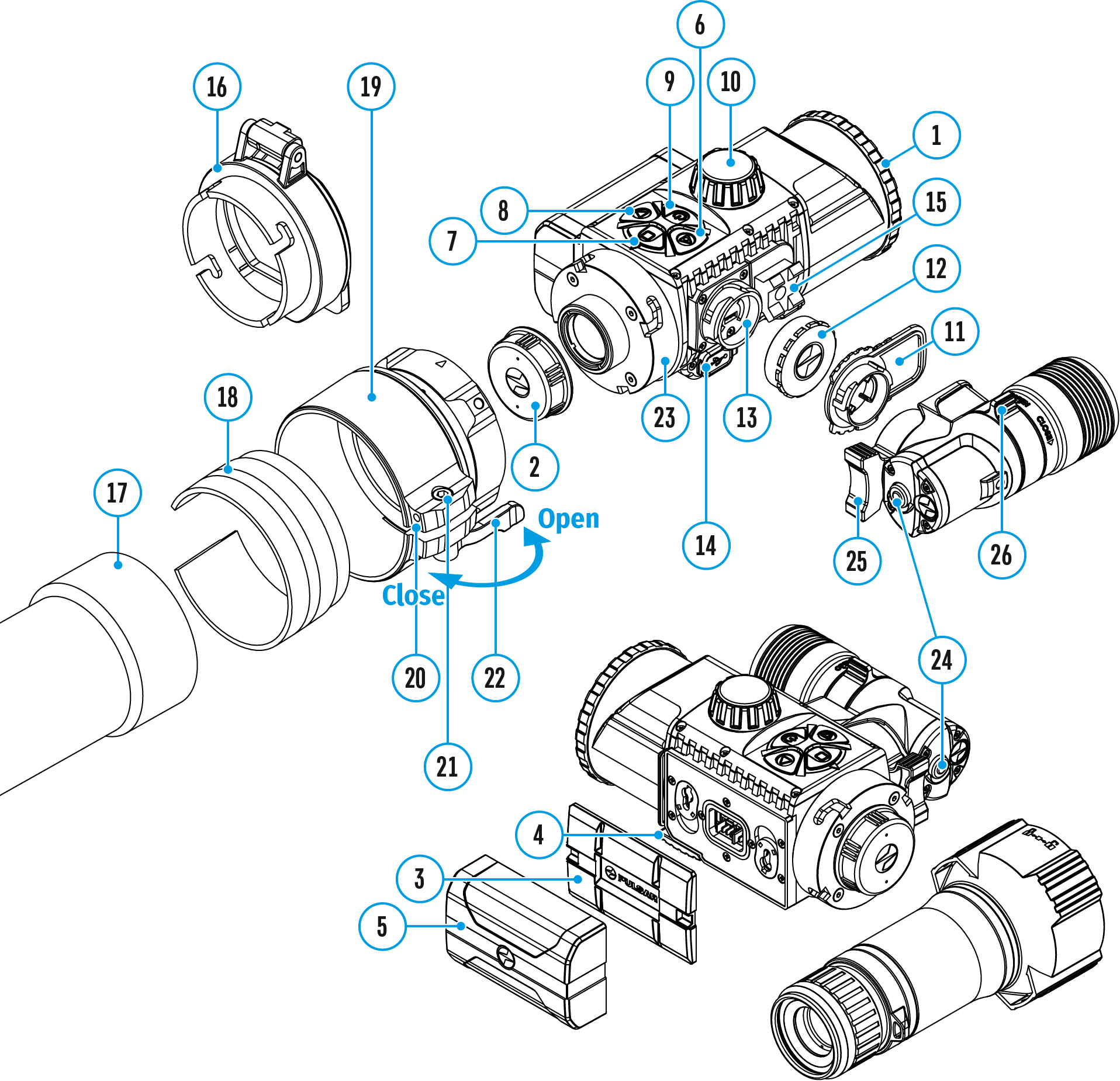
- Remove the lens cap (1) by turning it anticlockwise.
- Turn on the device with a short press of the ON/OFF (9) button. An image will appear on the display.
- Adjust the resolution of the icons on the display by rotating the diopter adjustment ring of your optical device. In future, it will not be necessary to rotate the eyepiece diopter adjustment ring, regardless of distance and other conditions.
- Rotate the lens focus ring (10) to focus on the object being observed.
- Basic settings (brightness and contrast adjustment) can be altered by using the quick menu.
- Power the device off after use with a long press of the ON/OFF (9) button.
Interface
Quick Menu Functions
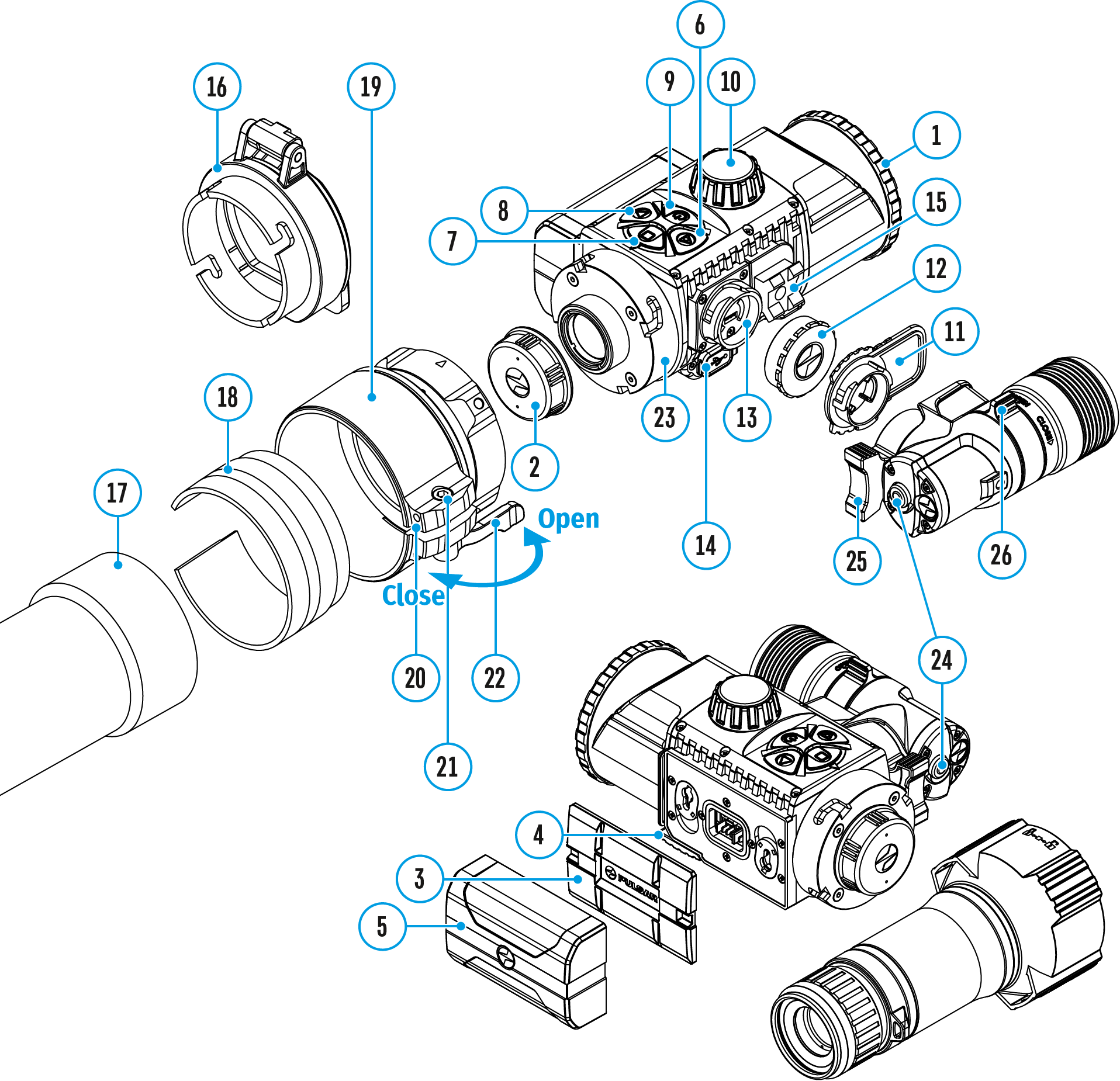
- Enter the quick menu with a short press of the M (7) button.
- A short press of the M (7) button enables you to switch between functions, as described below.
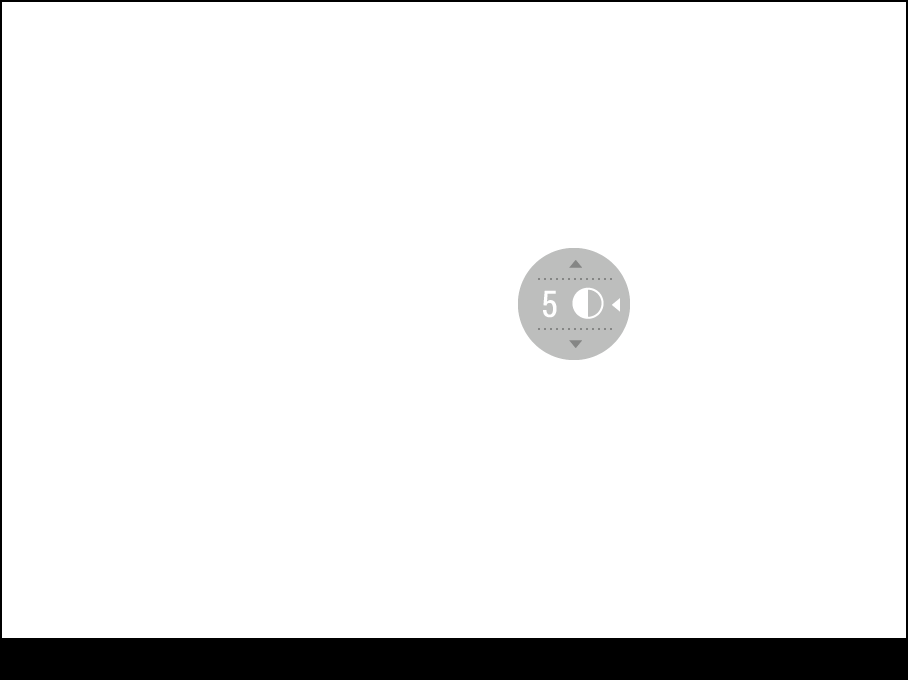
Contrast ![]() – by pressing the RIGHT (6) and LEFT (8) buttons and changing the display contrast value from 0 to 20.
– by pressing the RIGHT (6) and LEFT (8) buttons and changing the display contrast value from 0 to 20.
Brightness ![]() – by pressing the RIGHT (6) and LEFT (8) buttons and changing the display brightness value from 0 to 20.
– by pressing the RIGHT (6) and LEFT (8) buttons and changing the display brightness value from 0 to 20.
Status Bar

The status bar is at the bottom of the display and displays information on the actual operating status of the device, including:
- Auto shutdown function
 1 min (if activated)
1 min (if activated) - Microphone
- IR illuminator power level (e.g. Level 3)
- Power Indication:
![]() – Battery Pack charge level (when the device is powered by the Battery Pack)
– Battery Pack charge level (when the device is powered by the Battery Pack)
![]() – external battery power indicator (if the device is powered from an external supply)
– external battery power indicator (if the device is powered from an external supply)
![]() – battery charge indicator with current charge in percent (where charging is by an external power supply)
– battery charge indicator with current charge in percent (where charging is by an external power supply)
- The SumLight™ function
- Video recording status:
![]() – video recording is on
– video recording is on
![]() – pause
– pause
![]() – video recording is off
– video recording is off
- Wi-Fi Connection
- Time
- Bluetooth
Main Menu
Enter the Main Menu
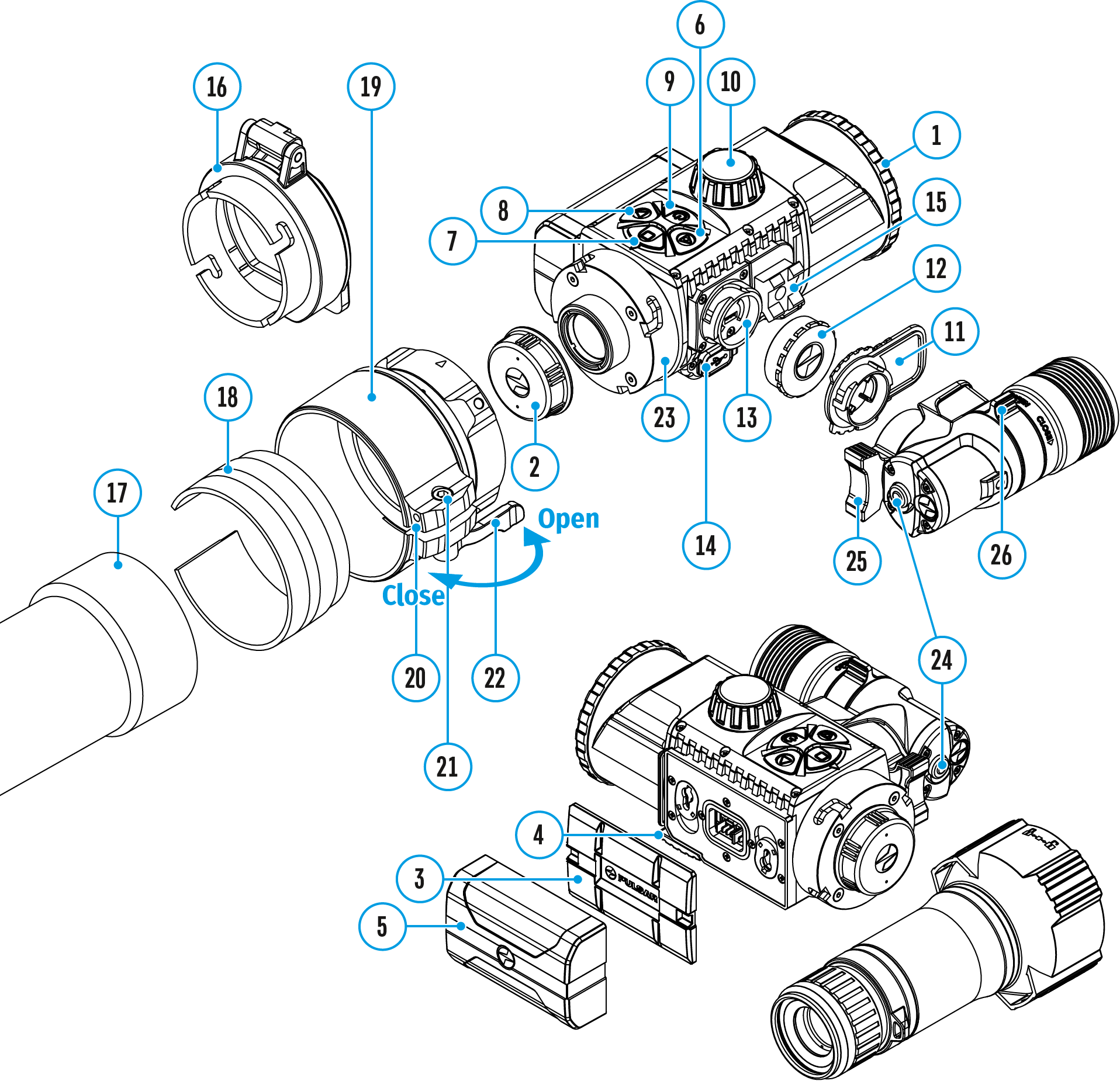
- Enter the main menu with a long press of the M (7) button.
- Press the RIGHT (6) and LEFT (8) buttons to toggle through the main menu functions.
- Open sub-items in the main menu with one short press of the M (7) button.
- To exit a sub-item in the main menu, press and hold down on the M (7) button.
- Automatic exit from the main menu occurs after 10 seconds of inactivity.
Note: When entering the main menu, the background image darkens to enhance the menu visibility. This is normal and not a defect.
General View of the Menu
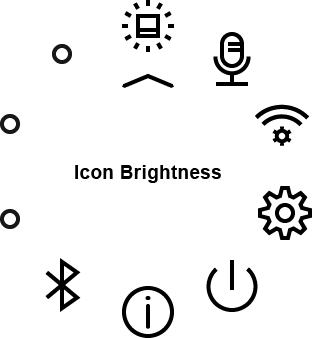
Icon Brightness
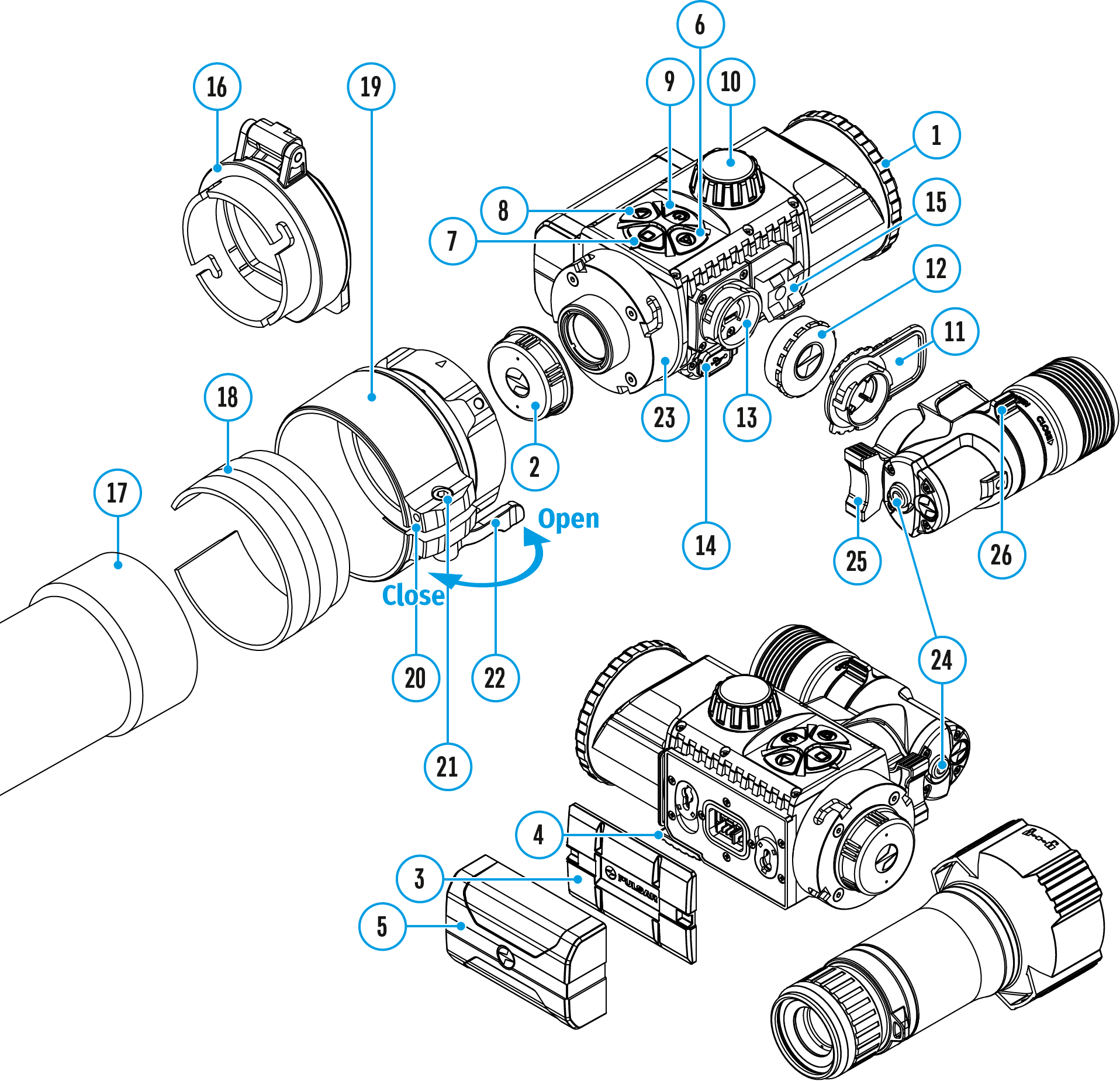
This menu item sets the brightness of icons on the attachment display.
- Press and hold the M (7) button to enter the main menu.
- Select submenu Icon Brightness
 with the RIGHT (6) and LEFT (8) buttons.
with the RIGHT (6) and LEFT (8) buttons. - A short press of the M (7) button opens the submenu.
- Change the brightness level of the icons with the RIGHT (6) and LEFT (8) buttons.
- Confirm your selection with a short press of the M (7) button.
Microphone
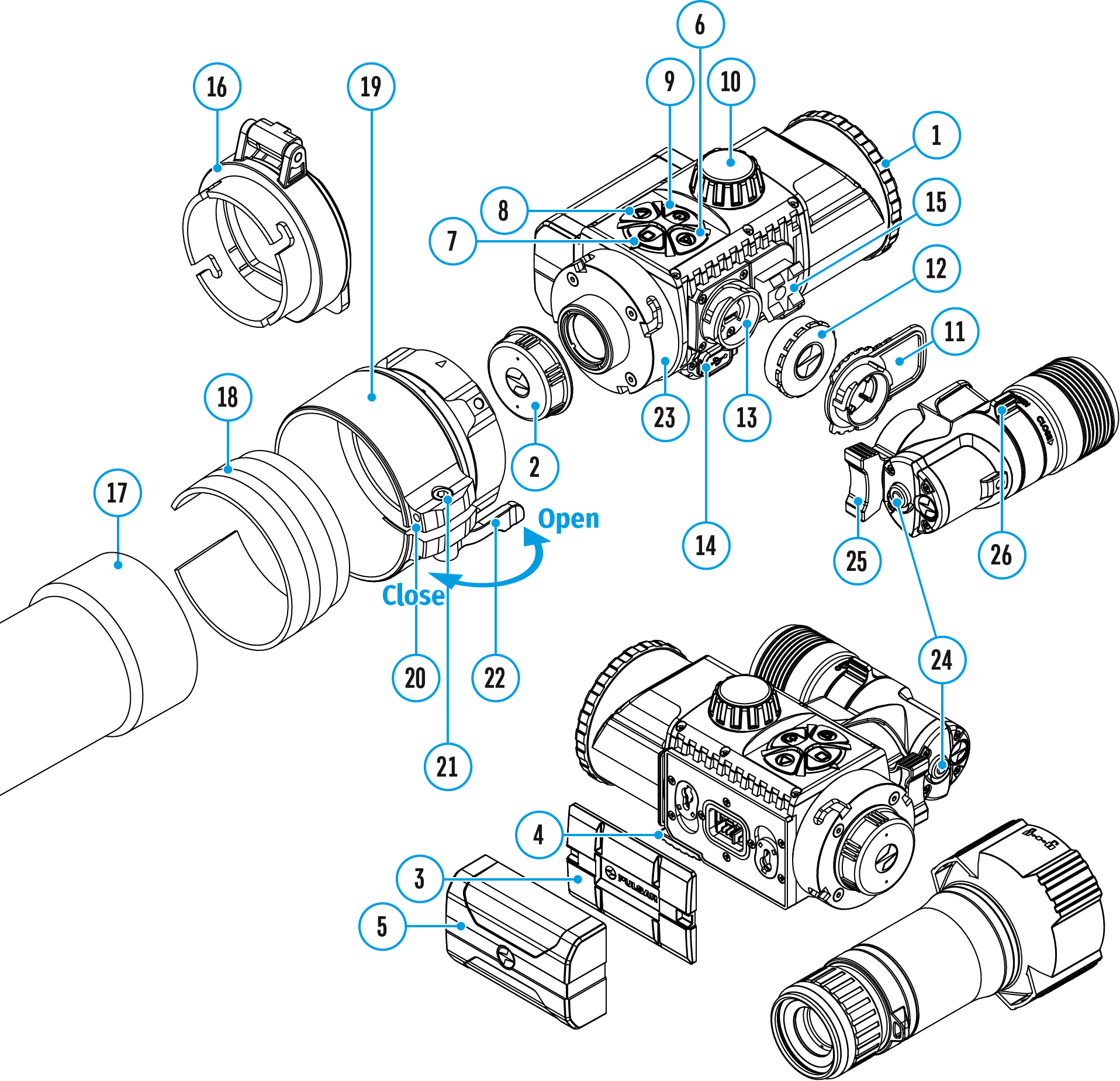
This item allows you to enable (or disable) the microphone for recording sound during video recording.
- Press and hold the M (7) button to enter the main menu
- Select Microphone
 option with the RIGHT (6) and LEFT (8) buttons.
option with the RIGHT (6) and LEFT (8) buttons. - A short press of the M (7) button opens the submenu.
- To turn the microphone on or off press RIGHT (6) or LEFT (8) buttons.
- Confirm your selection with a short press of the M (7) button.
Wi-Fi Settings
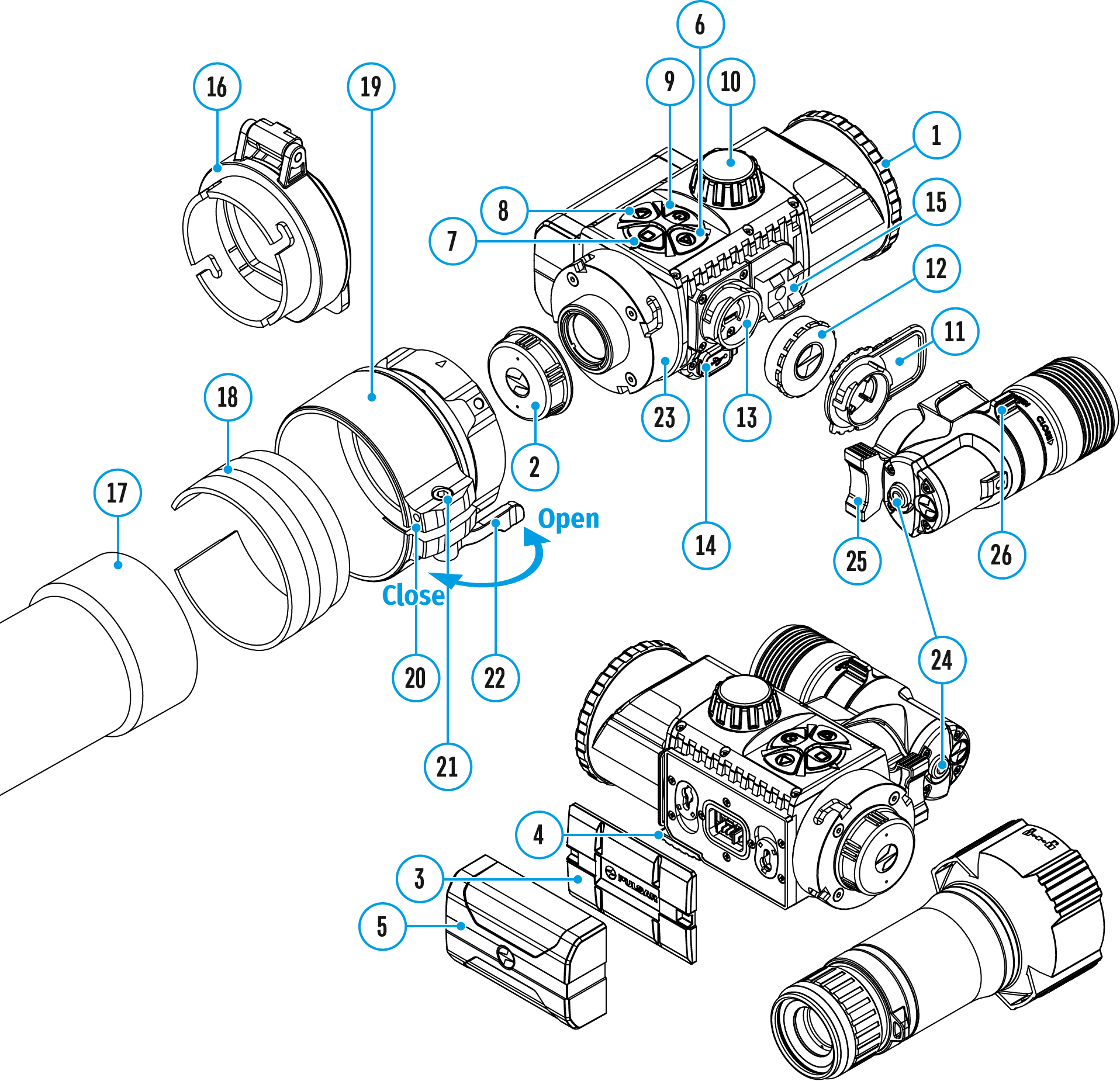
This option enables you to configure the device to operate on a Wi-Fi network.
Note: Wi-Fi is turned on/off with a long press of the LEFT (8) button.
- Press and hold the M (7) button to enter the main menu.
- Select Wi-Fi Settings
 submenu using the RIGHT (6) and LEFT (8) buttons.
submenu using the RIGHT (6) and LEFT (8) buttons. - A short press of the M (7) button opens the submenu.
- Select the desired menu item with the RIGHT (6) and LEFT (8) buttons.
Password Setup
This submenu allows you to set a password to access the device from an external device. This password is used when linking an external device (e.g. a smartphone) to the device.
- A short press of the M (7) button opens the Password Setup
 submenu.
submenu. - The default password (12345678) will appear on the screen.
- Set your desired password with the RIGHT (6) and LEFT (8) buttons. The RIGHT button increases the value and the LEFT button reduces it. Press the M (7) button to toggle the digits.
- Press and hold down the M (7) button to save the password and exit the submenu.
Access Level Setup
This sub-function enables you to configure the appropriate level of access to your device made available to the Stream Vision app.
- Owner level. A Stream Vision user has full access to all the device’s functions.
- Guest level. A Stream Vision user is only able to view video footage from the device in real time.
- A short press of the M (7) button opens the submenu Access Level Setup
 .
. - Select Owner or Guest with the RIGHT (6) and LEFT (8) buttons.
- Confirm your selection with a short press of the M (7) button.
General Settings
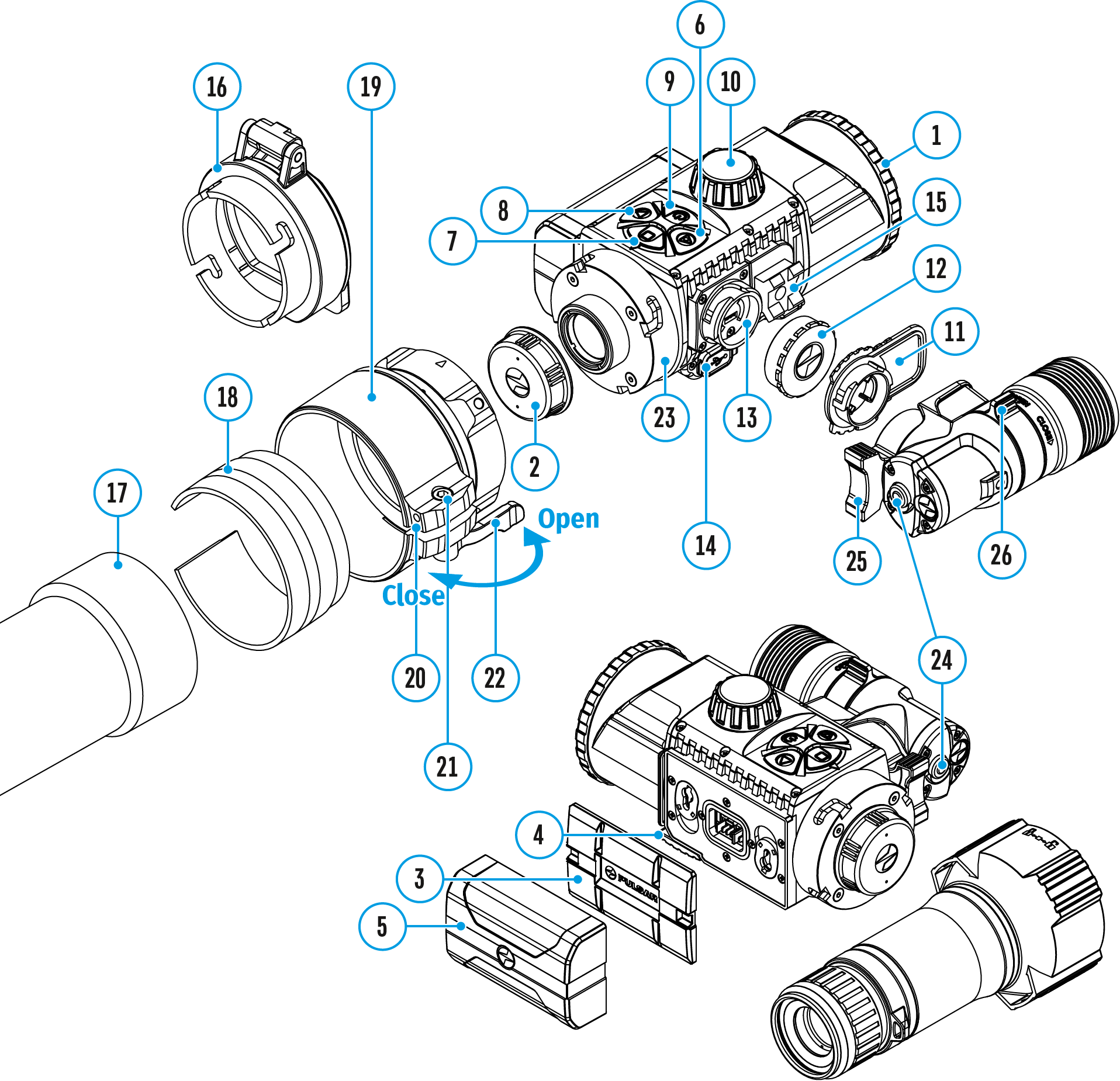
- Press and hold the M (7) button to enter the main menu.
- Select the submenu General Settings
 with the RIGHT (6) and LEFT (8) buttons.
with the RIGHT (6) and LEFT (8) buttons. - A short press of the M (7) button opens the submenu.
- Select the desired menu item with the RIGHT (6) and LEFT (8) buttons.
This menu item allows you to program the following settings:
Language
- A short press of the M (7) button opens the Language
 submenu.
submenu. - Select one of the available interface languages (English, French, German, Spanish or Russian) with the RIGHT (6) and LEFT (8) buttons.
- Confirm your selection with a short press of the M (7) button.
Date
- A short press of the M (7) button opens the submenu Date
 .
. - The date appears in dd/mm/yyyy format (01/01/2021).
- Set the required year, month and day with the RIGHT (6) and LEFT (8) buttons (the RIGHT (6) button increases the value and the LEFT (8) button reduces it). Press the M (7) button to toggle the digits.
- To save your chosen date and exit the submenu, press and hold the M (7) button.
Time
- A short press of the M (7) button opens the submenu Time
 .
. - Select the time format (24-hour clock or AM/PM) by pressing the RIGHT (6) and LEFT (8) buttons.
- Press the M (7) button to move to the hour setting.
- Set the hour with the RIGHT (6) and LEFT (8) buttons. The RIGHT (6) button increases the value and the LEFT (8) button reduces it.
- Press the M (7) button to move to the minute setting.
- Set the minute by pressing the RIGHT (6) and LEFT (8) buttons.
- To save your chosen time and exit the submenu, press and hold the M (7) button.
Default Settings
- A short press of the M (7) button opens the submenu Default Settings
 .
. - Select the ‘Yes’ option to reset to factory settings or ‘No’ to cancel using the RIGHT (6) and LEFT (8) buttons.
- Confirm your selection with a short press of the M (7) button.
The following settings will be restored to their factory state before being set by the user:
- Brightness level – 10
- Contrast level – 8
- Language – English
- Wi-Fi – off (default password)
- Auto shutdown – off
Format
Formatting the built-in memory card permanently deletes all of the recorded files.
Formatting should be carried out in case of a memory card error.
Attention! Make sure that you no longer need the files to be deleted or create a backup on other media.
- A short press of the M (7) button opens the submenu Format
 .
. - Select the ‘Yes’ option to format or ‘No’ to cancel using the RIGHT (6) and LEFT (8) buttons.
- Confirm your selection with a short press of the M (7) button.
Auto Shutdown
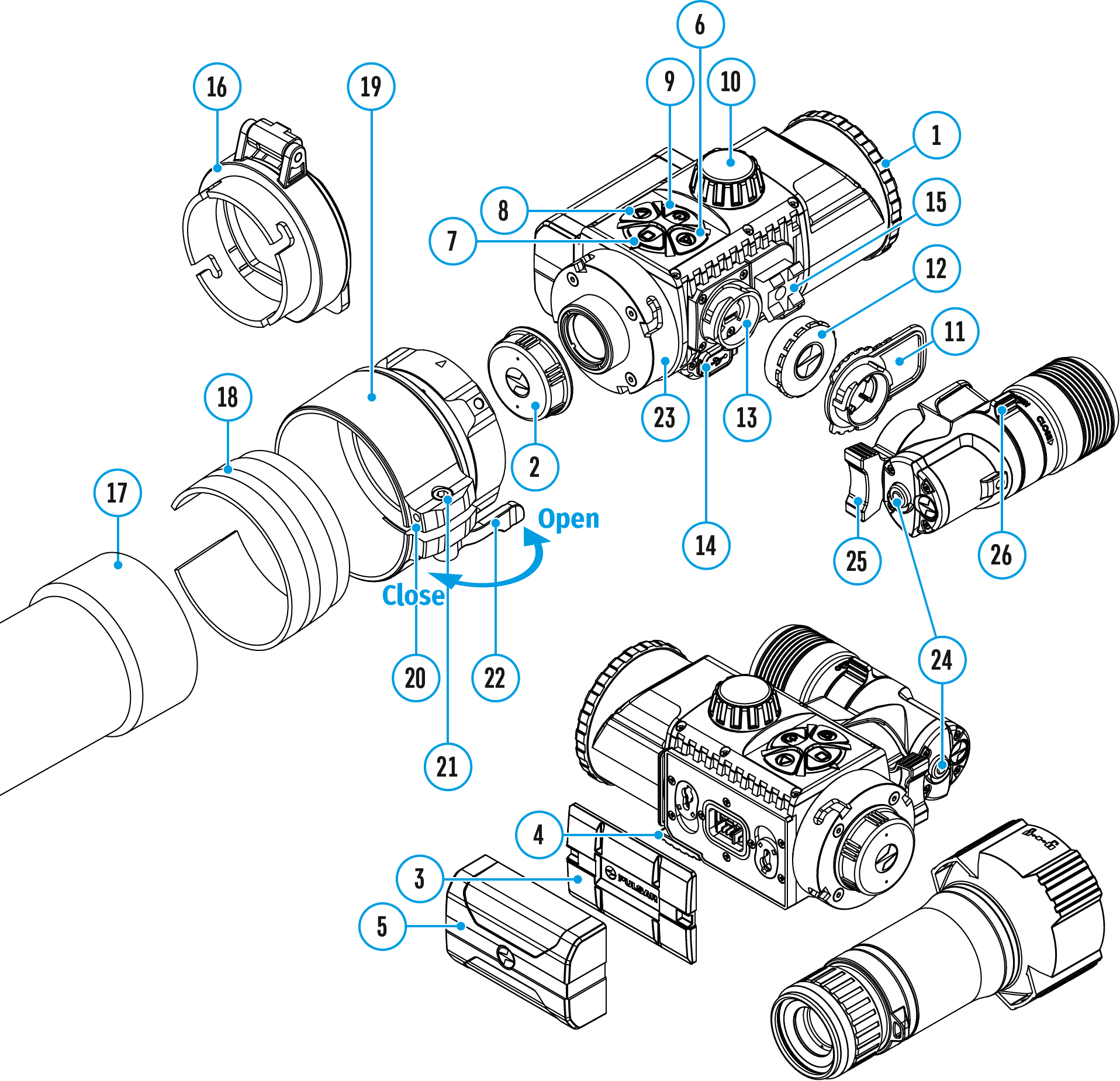
This function enables you to activate automatic shutdown of the device after a certain period of time when it is tilted up or down by more than 70°, or right or left by more than 30°. Meanwhile the device controls should not be activated.
- Press and hold the M (7) button to enter the main menu.
- Select the Auto Shutdown
 menu with the RIGHT (6) and LEFT (8) buttons.
menu with the RIGHT (6) and LEFT (8) buttons. - A short press of the M (7) button opens the submenu.
- Use the RIGHT (6) and LEFT (8) buttons to select the time period after which the device will automatically turn off (1 min; 3 min; 5 min), or select “Switch off” if you want to deactivate the automatic shutdown function.
- Confirm your selection with a short press of the M (7) button.
Note: the status bar will display Auto Shutdown status icon ![]() 1 min.
1 min.
Device Information
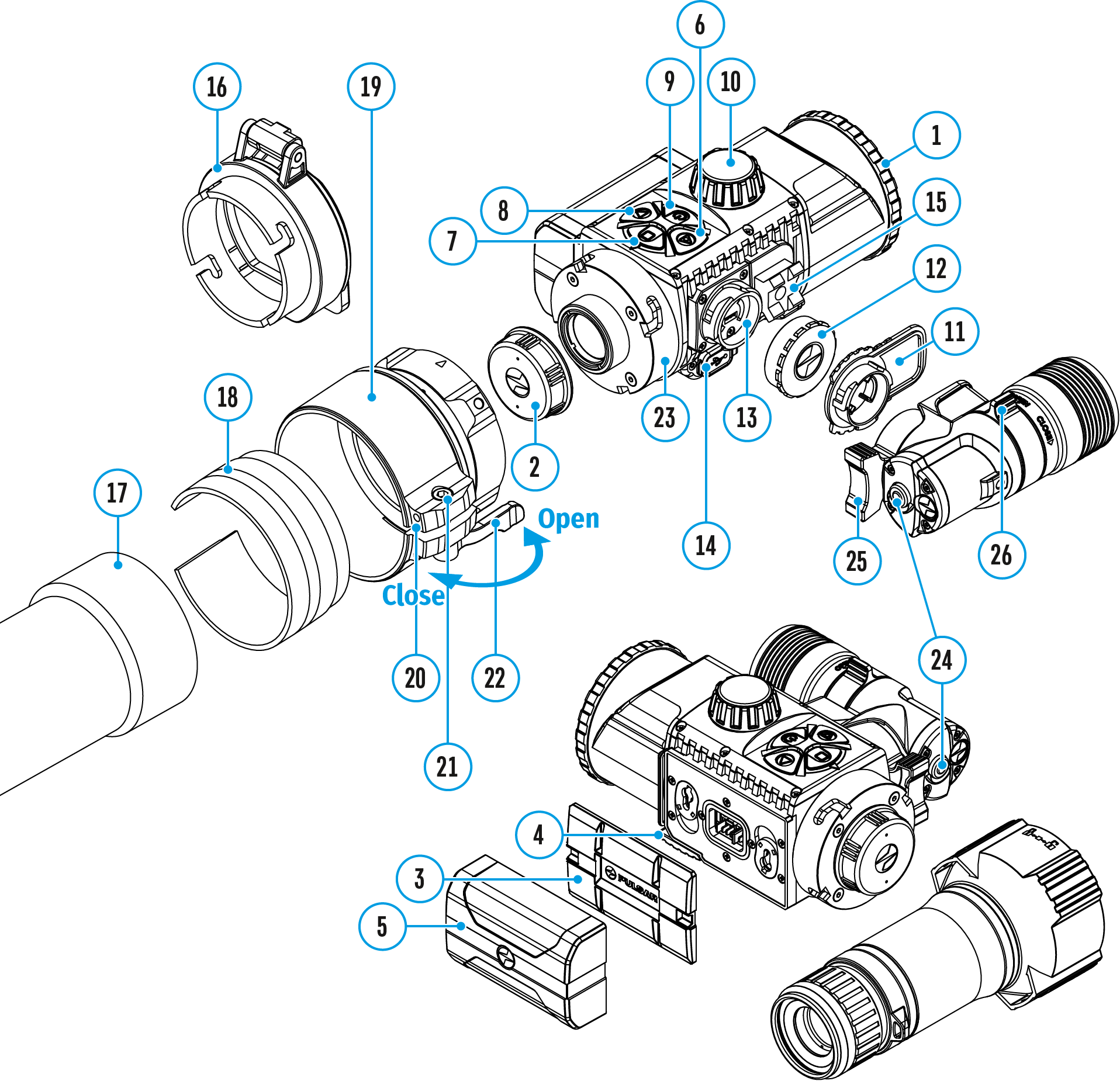
- Press and hold the M (7) button to enter the main menu.
- Select the Device Information
 menu with the RIGHT (6) and LEFT (8) buttons.
menu with the RIGHT (6) and LEFT (8) buttons. - A short press of the M (7) button opens the submenu.
The user has access to the following information about the device:
- full name
- SKU number
- serial number
- firmware version
- hardware version
- service information
Bluetooth
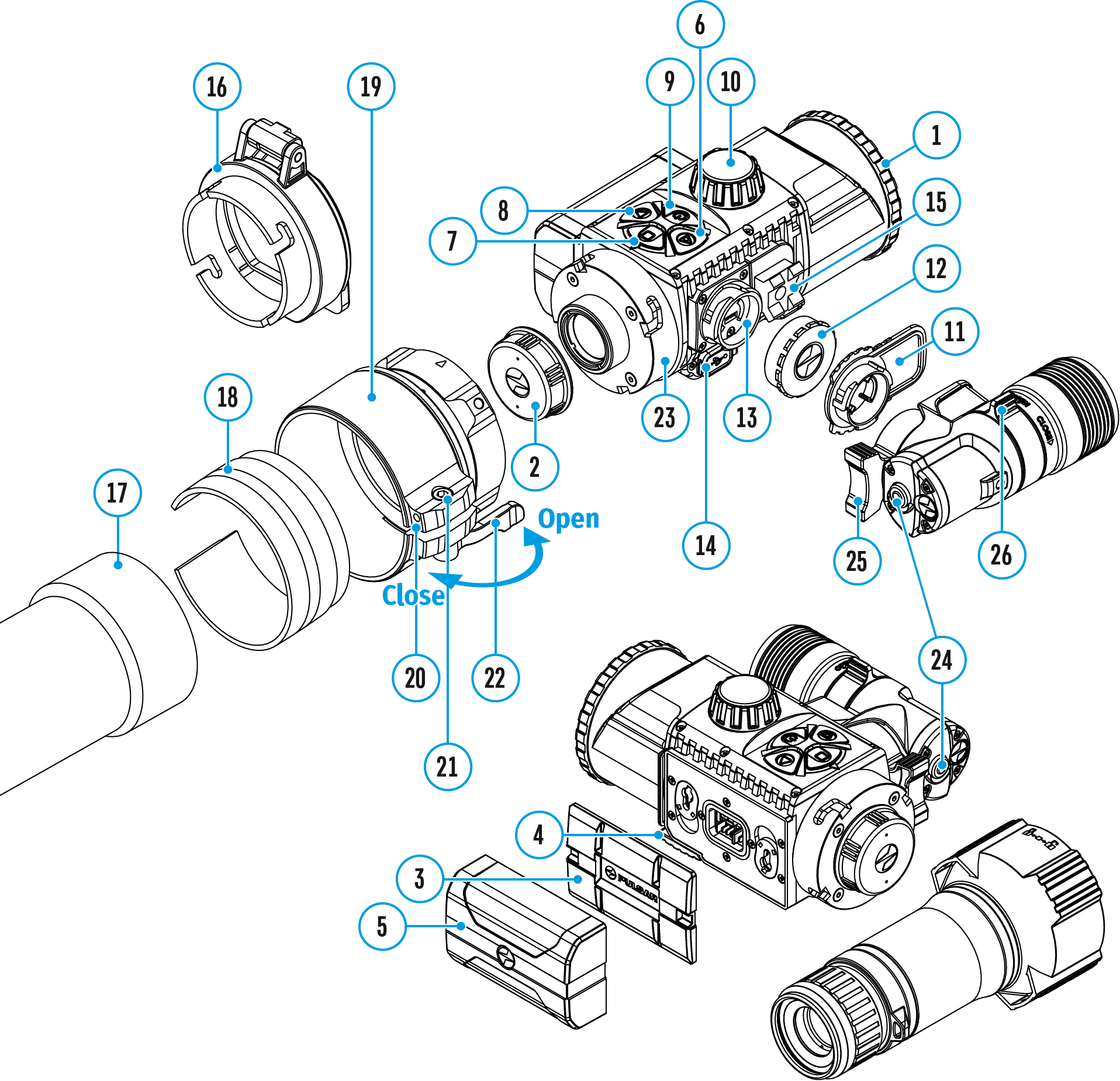
Turn on/off Bluetooth
- Press and hold the M (7) button to enter the main menu.
- Select the Bluetooth
 submenu with the RIGHT (6) and LEFT (8) buttons.
submenu with the RIGHT (6) and LEFT (8) buttons. - A short press of the M (7) button opens the submenu.
- Turn Bluetooth on/off with a short press of the M (7) button.
- Press and hold down the M (7) button to exit the submenu.
The process of connecting the wireless remote control is described in the Remote Control Activation section.
Functions
USB Connection
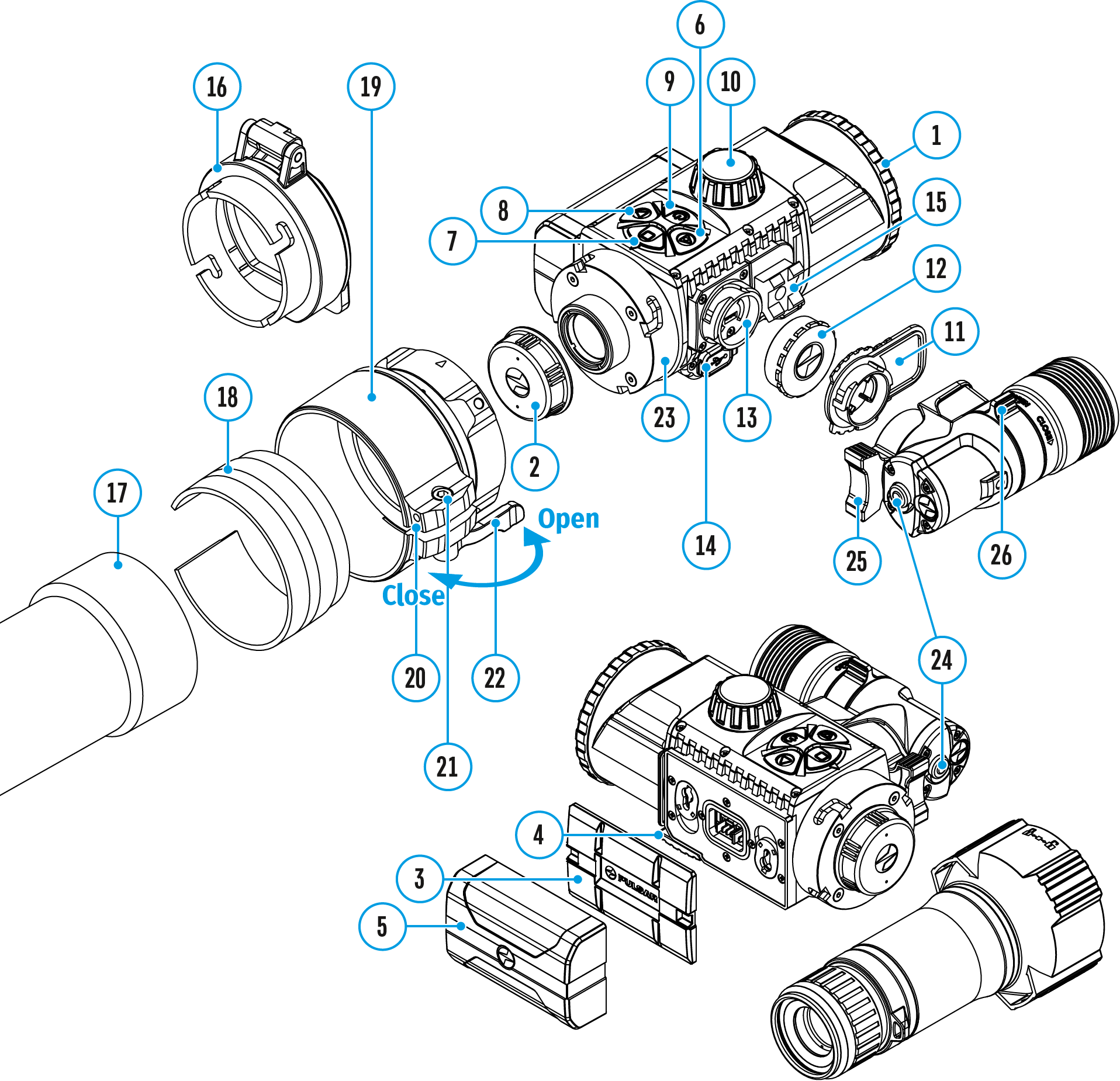
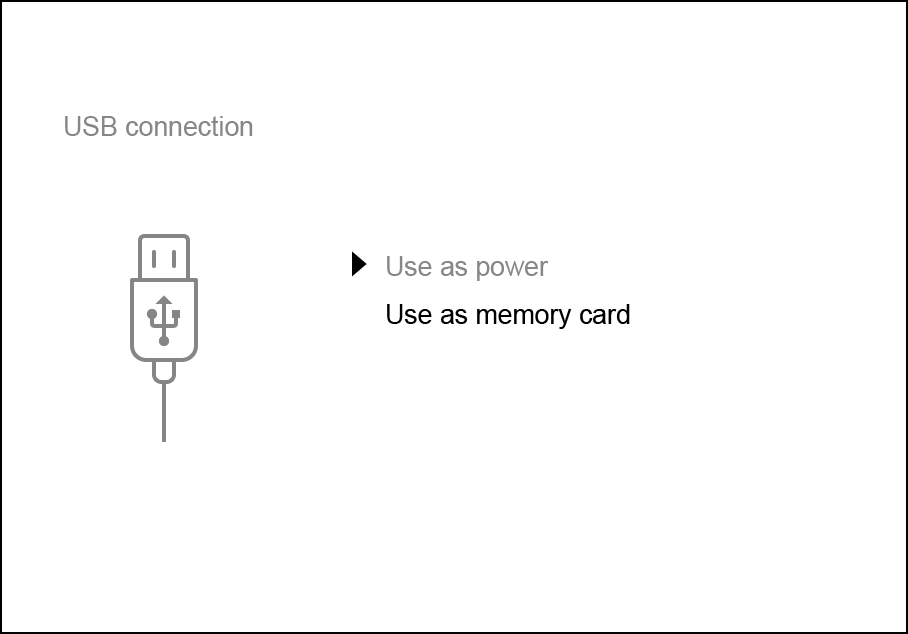
- Power on the device by pressing the ON/OFF (9) button (the computer will not detect the device if it is turned off).
- Connect one end of the USB cable to the device’s microUSB connector (14) and the other end to the port on your computer.
- The device is detected automatically by the computer and no installation of drivers is required.
- Two connection modes will appear on the display: Power and Memory card.
- Select the connection mode with the RIGHT (6) and LEFT (8) buttons.
- A short press of the M (7) button confirms the selection.
Power
- When this mode is selected, the computer is used by the device as an external power supply. An icon
 will appear in the status bar.
will appear in the status bar. - The device will continue to function and all functions are available.
- The battery pack installed in the device will not be charged.
Memory card
- When this mode is selected, the device will be recognised by the computer as a flash card.
- This option is designed for working with files that are stored in the device’s memory; the device’s functions are not accessible and the device turns itself off. The device continues to function after disconnection from the computer.
- If a video was being recorded at the time of connection, the recording will cease and will be saved.
Disabling the USB
- When disconnecting the USB from the device in Power mode, the device will continue to function with the Battery Pack, if it is available and has sufficient charge.
- When the USB is disconnected from the device connected in Memory card mode, the device remains switched on.
Using the Weaver Rail
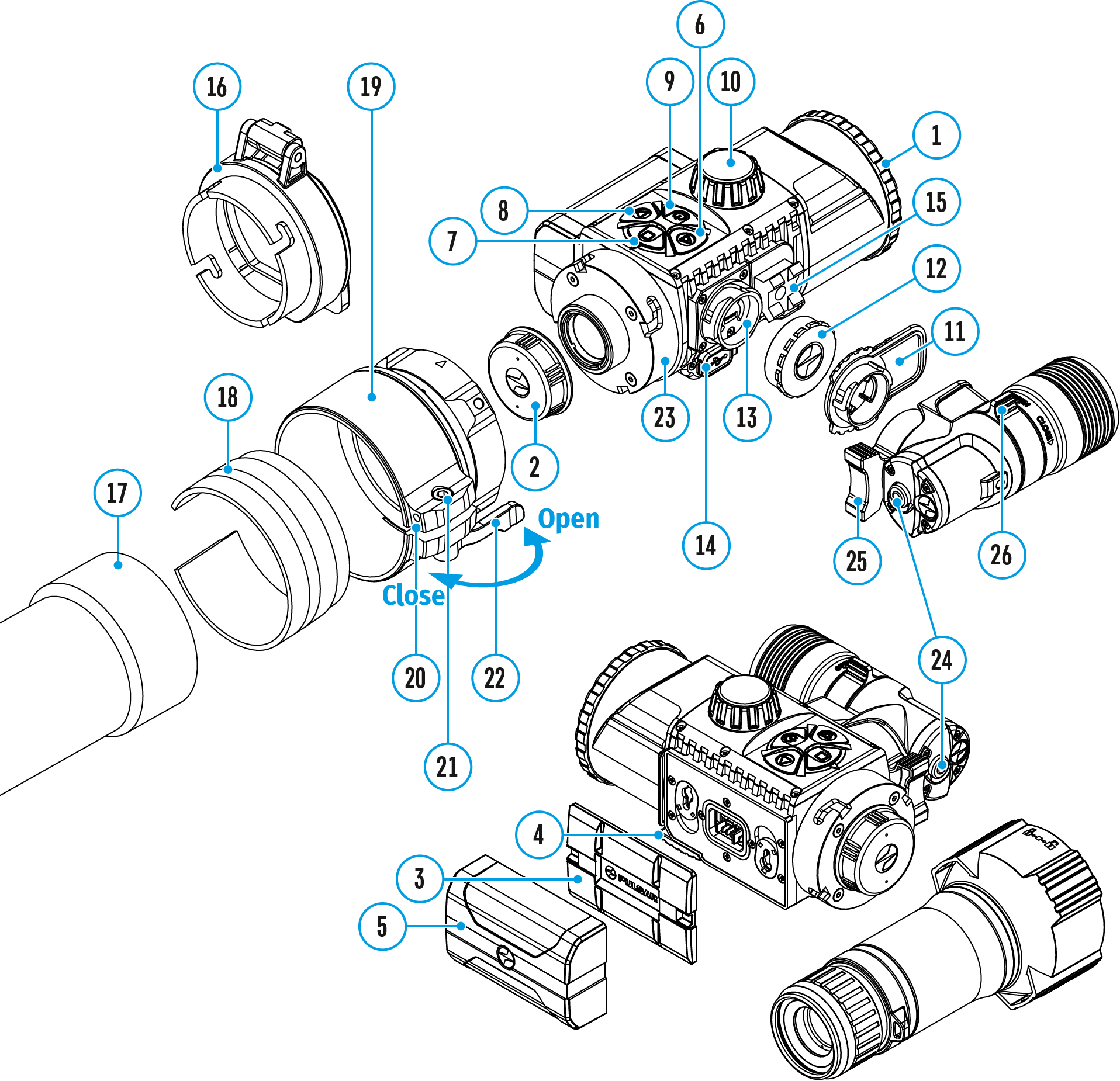
The device is equipped with a Weaver rail (15) which allows the user to mount extra accessories.
You must first detach the removable IR illuminator (see section Removing the IR Illuminator).
Remote Control Activation

- Turn on the Bluetooth module (see the Bluetooth section).
- In the Bluetooth
 section of the menu, use the RIGHT (6) and LEFT (8) buttons to select the Scan
section of the menu, use the RIGHT (6) and LEFT (8) buttons to select the Scan  menu item.
menu item. - Confirm your selection with a short press of the M (7) button.
- Press and hold any button on the Remote Control. The Remote Control is visible in the Bluetooth network and can be connected during this time.
- Use the RIGHT (6) and LEFT (8) buttons to select the remote control from the dropdown list that appears.
- Confirm your selection with a short press of the M (7) button.
Notes:
- Once paired, the Remote Control can operate the Pulsar device.
- Going forward, the Remote Control will automatically connect to the paired device when within visible range.
- The name of the remote control and its battery charge level will appear in the list of paired devices at the bottom of the display in the Bluetooth
 section of the menu.
section of the menu.
Descriptions of Controls
The wireless remote control duplicates the functions of turning off the device, turning off the display, controlling the IR illuminator, video recording and photographing, and it allows navigation through the menu.
| Controller (33) | Button (34) | Button (35) | Button (36) | ||
| Short press | Enter the quick menu and submenus of the main menu / confirm the selection / Switch to the next item of the quick menu | Turn the display on | Turn on the IR illuminator / Switch the IR power level |
Start video recording / Capture a photo | |
| Long press | Enter/exit the main menu / Exit the quick menu | Turn the display off / Turn the device off | Turn off the IR illuminator | Switch to photo/video mode | |
| Clockwise rotation | Quick menu | Increase parameter | 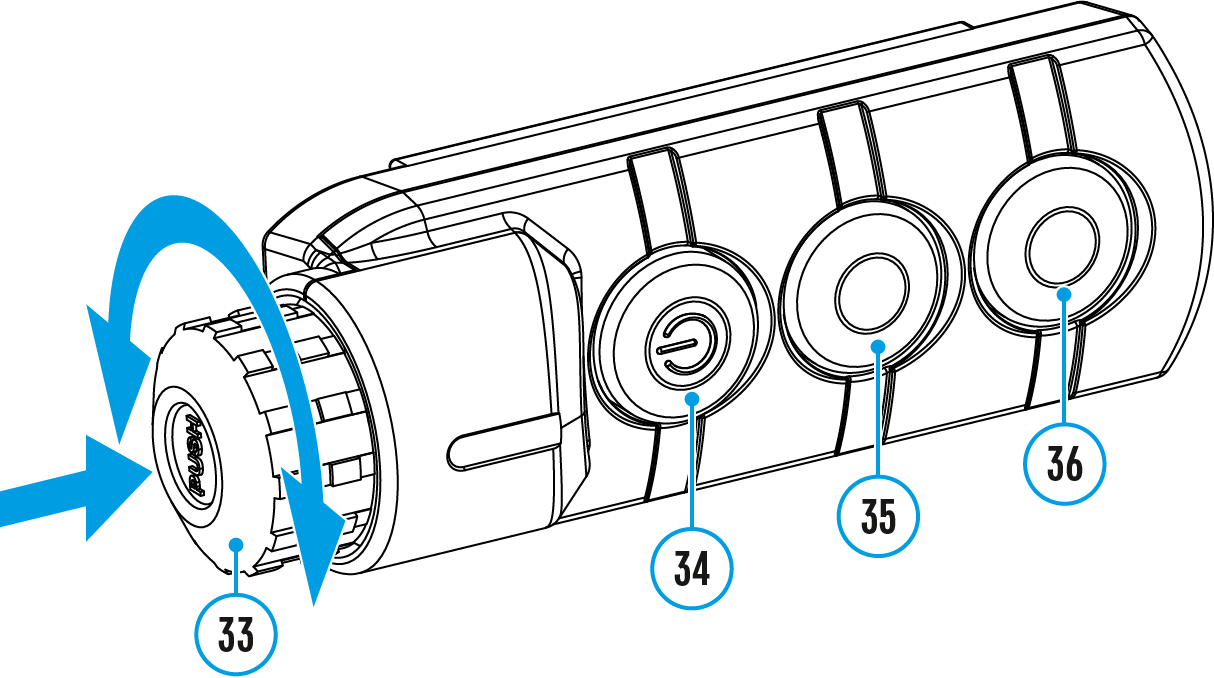 |
||
SumLight™ Function
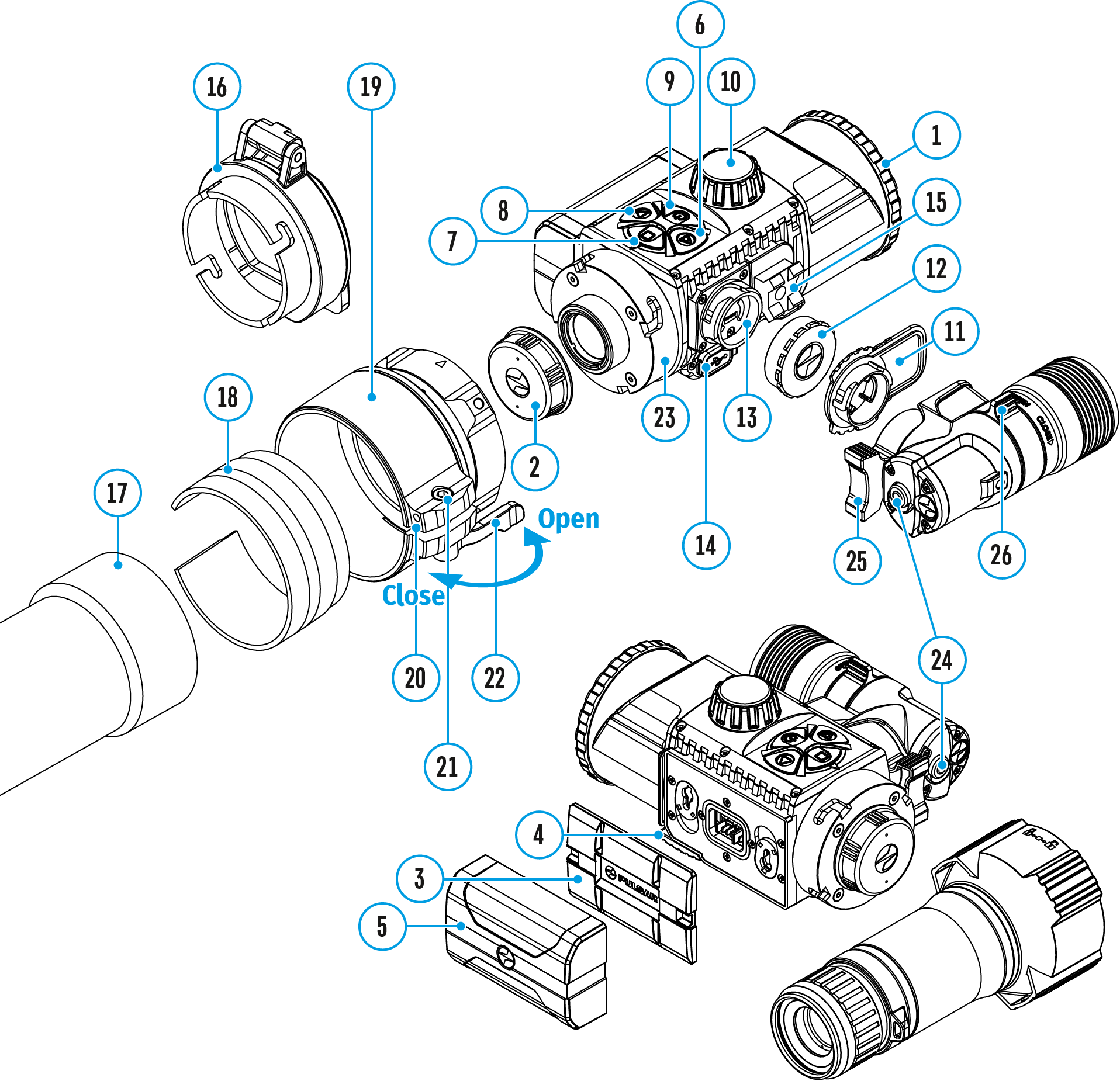
The SumLight™ function substantially increases the sensitivity of the CMOS array in the event of a reduction in the light level, thus enabling observation in conditions of low light without using the IR illuminator.
- Turn off the IR illuminator before using the SumLight ™ function.
- To activate the SumLight™ function, press briefly the LEFT (8) button.
- Press the LEFT (8) button once more to switch off.
- The SumLight™ icon (on
 or off
or off  ) is displayed in the status bar.
) is displayed in the status bar.
Attention! When the SumLight™ function is activated, the noise level in the image increases, the frame rate decreases and the image slows down. Any sharp movement of the device may cause the image to become “blurred”. Such effects are not defects. Luminous white dots (pixels) may be visible on the device’s display. The number of dots may increase when the SumLight™ function is enabled. This is due to the nature of how this function works and is not a defect.
Display-Off Function
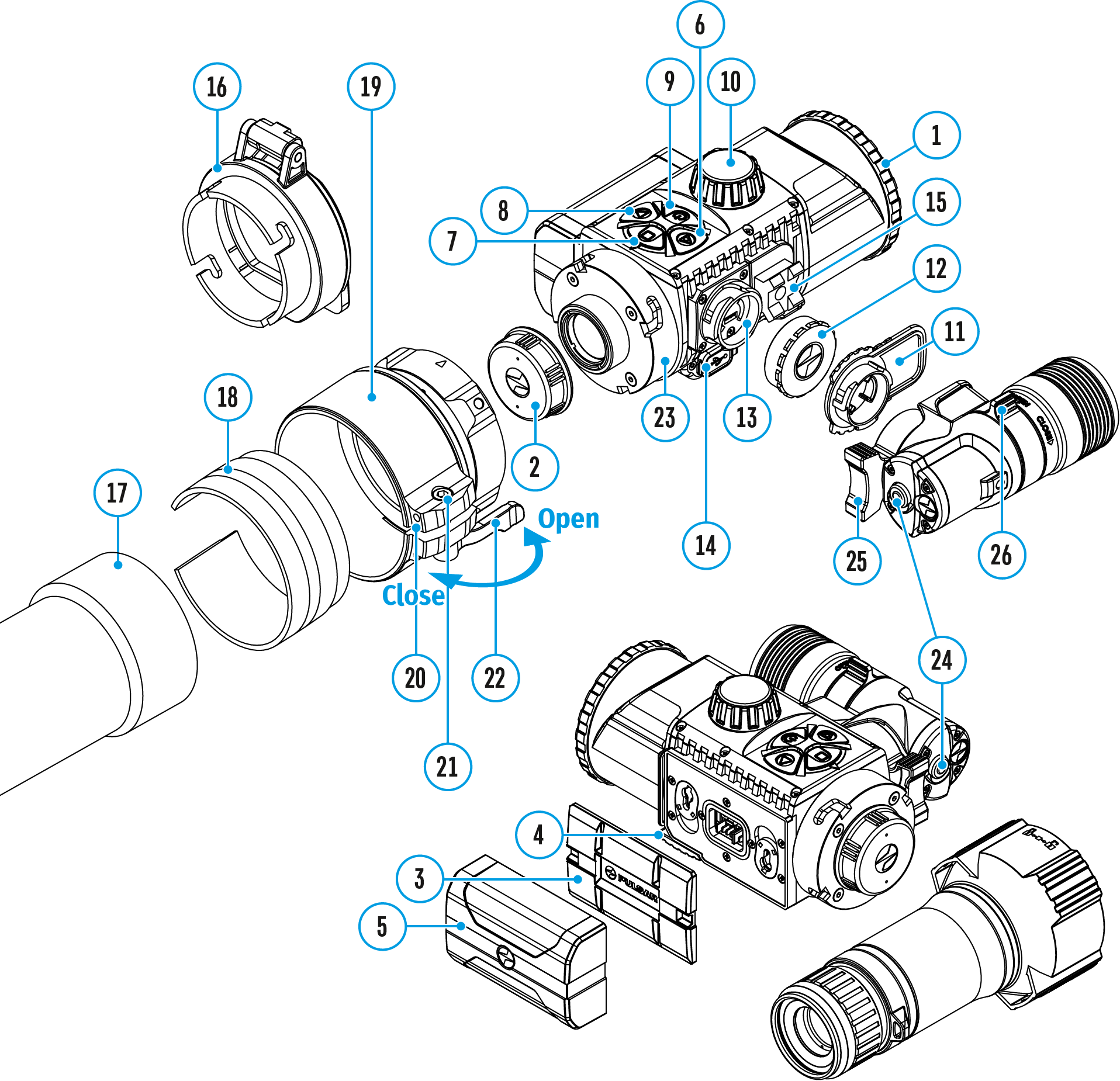
When this function is in use, the device switches to standby mode, which allows it to be turned off quickly if necessary.
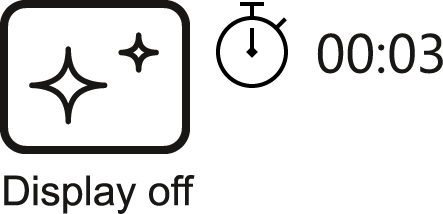
- When the device is on, press and hold the ON/OFF (9) button for less than 3 seconds. The display goes blank and the message “Display off”.
- Press the ON/OFF (9) button briefly to turn on the display.
- When you press and hold the ON/OFF (9) button, the display shows the message “Display off” with a countdown. Holding the button down for the duration of the countdown will power the device off completely.
Wi-Fi Function
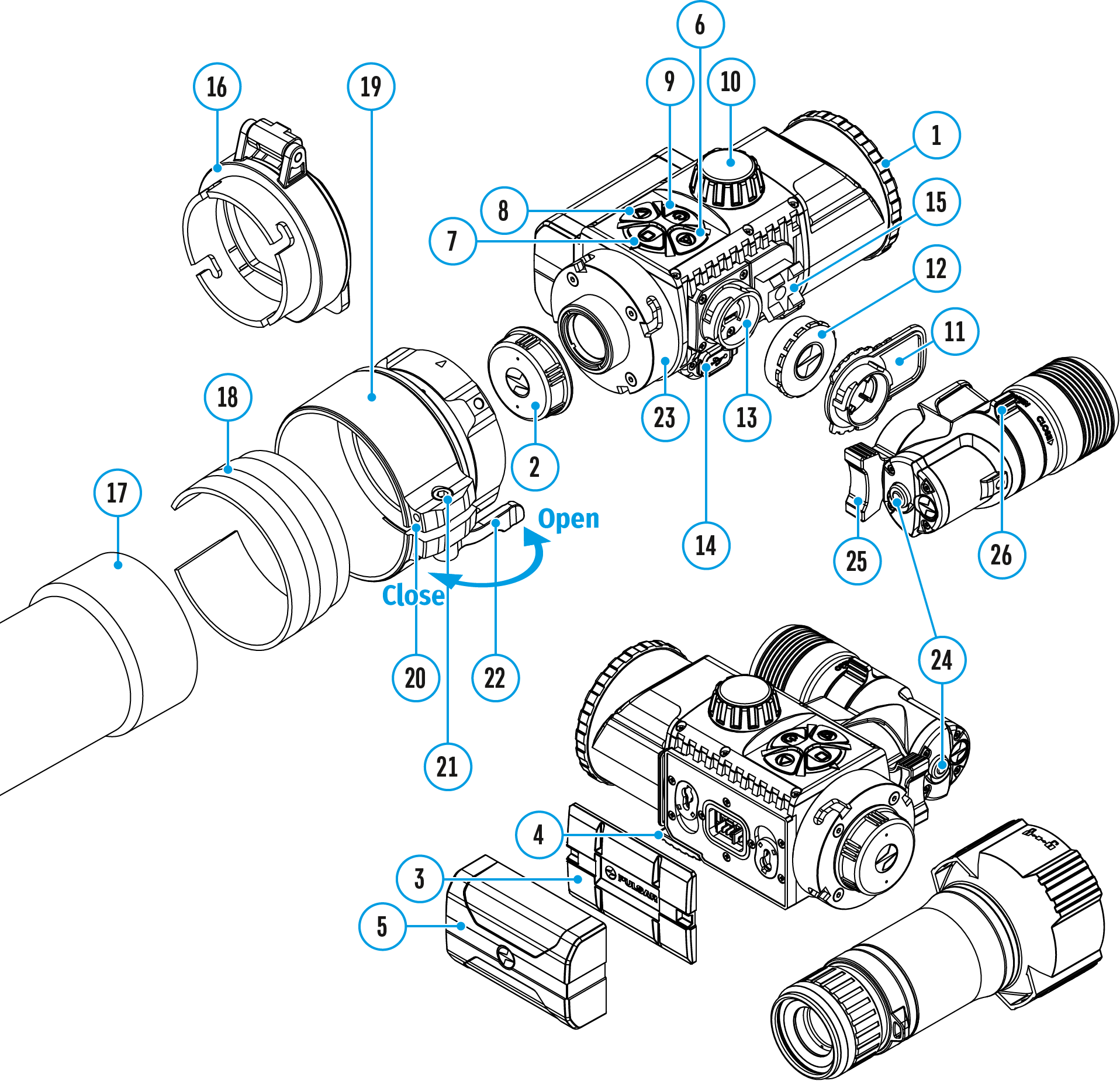
The device has a function for wireless communication with external devices (smartphone or tablet) via Wi-Fi.
- Turn on the wireless connection module with a long press of the LEFT (8) button.
Wireless operation is displayed in the status bar in the following:
| Connection Status | Indication on the status bar |
| Wi-Fi disconnected | No icon |
| Wi-Fi turned on by the user, Wi-Fi connection in the device is in progress | |
| Wi-Fi turned on, no connection to the device | |
| Wi-Fi turned on, the device is connected |
- The device is recognised by a mobile device under the label “Forward F_XXXX”, where XXXX are the four last digits of the serial number.
- Once the password has been entered on the mobile device (for more information on setting a password, see the Password Setup subsection in the Wi-Fi Settings section) and the connection has been established, the icon
 in the status bar changes to
in the status bar changes to  , the video signal on the mobile device screen starts after the “viewfinder” button is activated on the screen of the mobile device. The icon in the status bar changes to
, the video signal on the mobile device screen starts after the “viewfinder” button is activated on the screen of the mobile device. The icon in the status bar changes to  .
.
Note: you can configure the required access level to your device that is granted to the Stream Vision application in the Access Level Setup ![]() subsection in the Wi-Fi Settings
subsection in the Wi-Fi Settings ![]() menu section.
menu section.
Video Recording and Photography
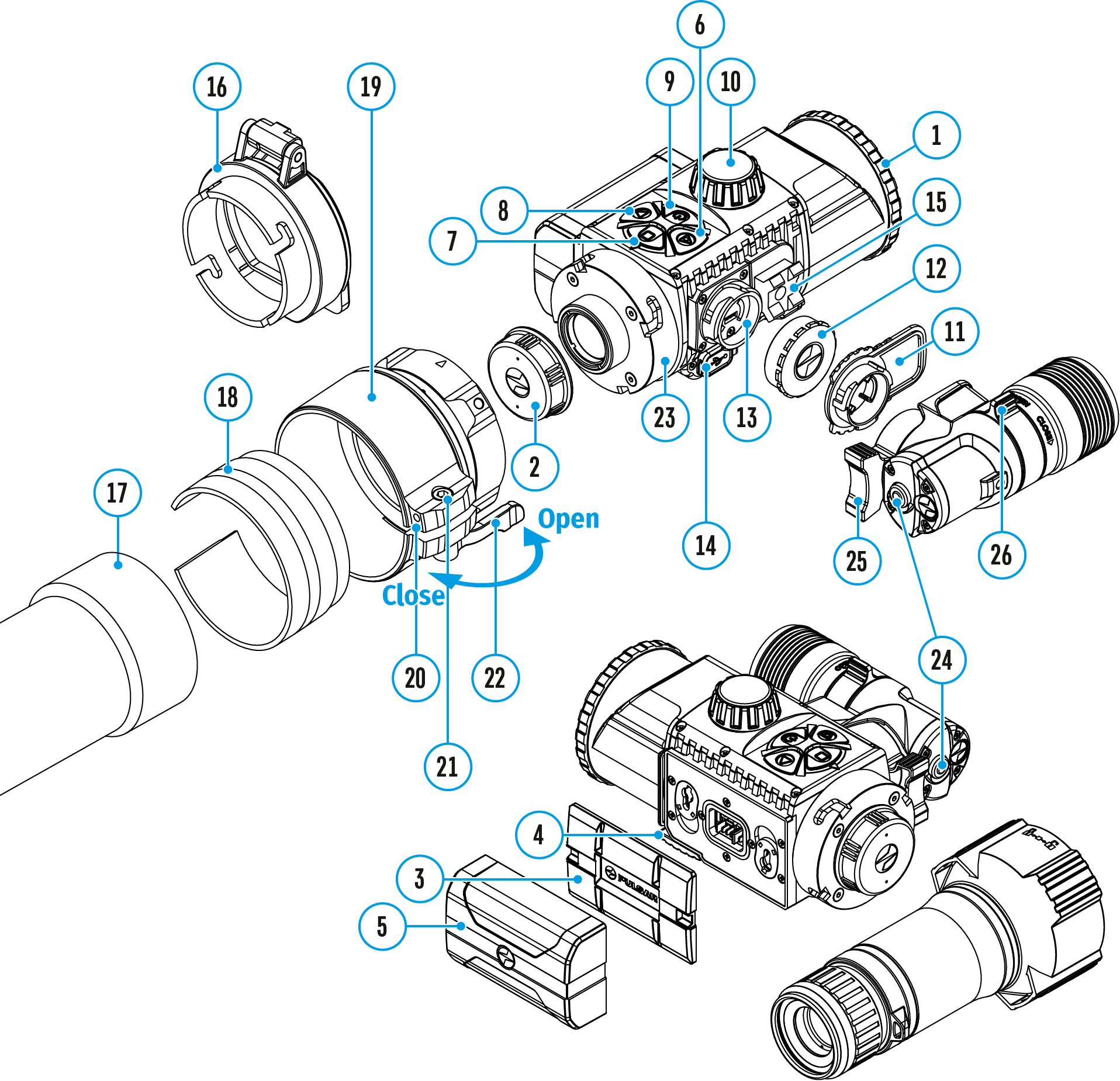
The device is equipped with a function for video recording (and photographing) an observed image that is saved onto the built-in memory card.
It is recommended to set the date and time (see the General Settings section) before using the photo and video functions.
For information on how to watch recorded photos and videos, see the Stream Vision 2 user manual: Android, iOS.
The built-in recorder operates in two modes:
- Photo (photography; in the top right corner of the display you can see an icon
 ). If the estimated number of photos that can be saved to the Flash card is more than 100, the message “>100” is shown.
). If the estimated number of photos that can be saved to the Flash card is more than 100, the message “>100” is shown. - Video (video recording; an icon
 is displayed in the upper left of the display, the total remaining recording time given the current resolution in HH:MM:SS format (hours : minutes : seconds).
is displayed in the upper left of the display, the total remaining recording time given the current resolution in HH:MM:SS format (hours : minutes : seconds).
To toggle between Video and Photo modes press and hold down the RIGHT (6) button. Switching between the modes toggles Video–> Photo–> Video…
Photo mode. Photographing an image
- Switch to Photo mode with a long press of the RIGHT (6) button.
- To capture a photo, press the RIGHT (6) button briefly. The image freezes for 0.5 sec.
- The photo is saved to the internal memory.
Video Mode Recording video clips
- Switch to Video mode with a long press of the RIGHT (6) button.
- The icon
 and the remaining recording time in HH:MM (Hours:Minutes) format are displayed in the upper left corner, for example, 5:12*. In the status bar, the video recording status is displayed continuously.
and the remaining recording time in HH:MM (Hours:Minutes) format are displayed in the upper left corner, for example, 5:12*. In the status bar, the video recording status is displayed continuously. - Start video recording with a short press of the RIGHT (6) button.
- When the video recording starts, the icon
 will disappear and the REC icon and timer in MM:SS (Minutes:Seconds) format will appear.
will disappear and the REC icon and timer in MM:SS (Minutes:Seconds) format will appear. - Press the RIGHT (6) button briefly to pause or resume video recording.
- Stop the video recording by pressing and holding down the RIGHT (6) button.
- Video files are stored in the internal memory card:
- After turning off the video recorder;
- When you turn off the device if the recorder had been turned on;
- If the memory card is full, or if during a video recording the memory becomes full (a “Memory full” message appears on the display).
* an icon will be displayed for 2 seconds and then disappear. When the RIGHT (6) or M (7) button is briefly pressed again, an icon will appear and the recording timer will show the current time of the video recording.
Notes:
- You can enter and navigate the menu during video recording.
- Recorded videos and photographs are saved to the device’s built-in memory card in the format: img_xxx.jpg (for photos); video_xxx.mp4 (for video). xxx – three-digit common file counter (for photos and video).
- The counter used for the names of multimedia files cannot be reset.
- If a file is deleted from the middle of the list, its number is not taken by another file.
- When the counter is full, a new folder is created – img_xxxx, where xxxx is the file counter.
- The maximum duration of a recorded video file is 5 minutes. After this time expires, a video is recorded onto a new file. The number of files is limited by the capacity of the device’s built-in memory.
- Regularly check the free memory on the internal memory card, moving footage and photographs to other storage media to free up space.
- In case of a memory card error, you can use the format function in the General Settings section of the main menu.
- Graphic information (status bar, icons etc.) is displayed in recorded video files and photos.
- When the Display Off function is activated, video recording is paused.
Software
Firmware Update
Stream Vision 2
- Download free Stream Vision 2 App in Google Play or App Store.
- Connect your Pulsar device to your mobile device (smartphone or tablet).
- Launch Stream Vision 2 and go to section “Settings”.
- Select your Pulsar device and press “Check firmware update”.
- Wait for the update to download and install. Pulsar device will reboot and will be ready to operate.
Important:
- if your Pulsar device is connected to phone, please turn on mobile data transfer (GPRS/3G/4G) to download update;
- if your Pulsar device is not connected to your phone but is already listed in “Settings” > “My devices” section, you may use Wi-Fi to download update.
Find answers to frequently asked questions about using Stream Vision 2 here.
Stream Vision
- Download free of charge Stream Vision App on Google Play or App Store.
- Connect your Pulsar device to your mobile device (smartphone or tablet).
- Launch Stream Vision and go to section “My Devices”.
- Select your Pulsar device and press “Check Updates”.
- Wait for the update to download and install. Pulsar device will reboot and will be ready to operate.
Important:
- if your Pulsar device is connected to phone, please turn on mobile data transfer (GPRS/3G/4G) to download update;
- if your Pulsar device is not connected to your phone but it’s already in the “My Devices” section, you may use Wi-Fi to download update.
Find answers to frequently asked questions about using Stream Vision here.
Is your firmware up to date?
Click here to check the latest firmware for your device.
Stream Vision 2
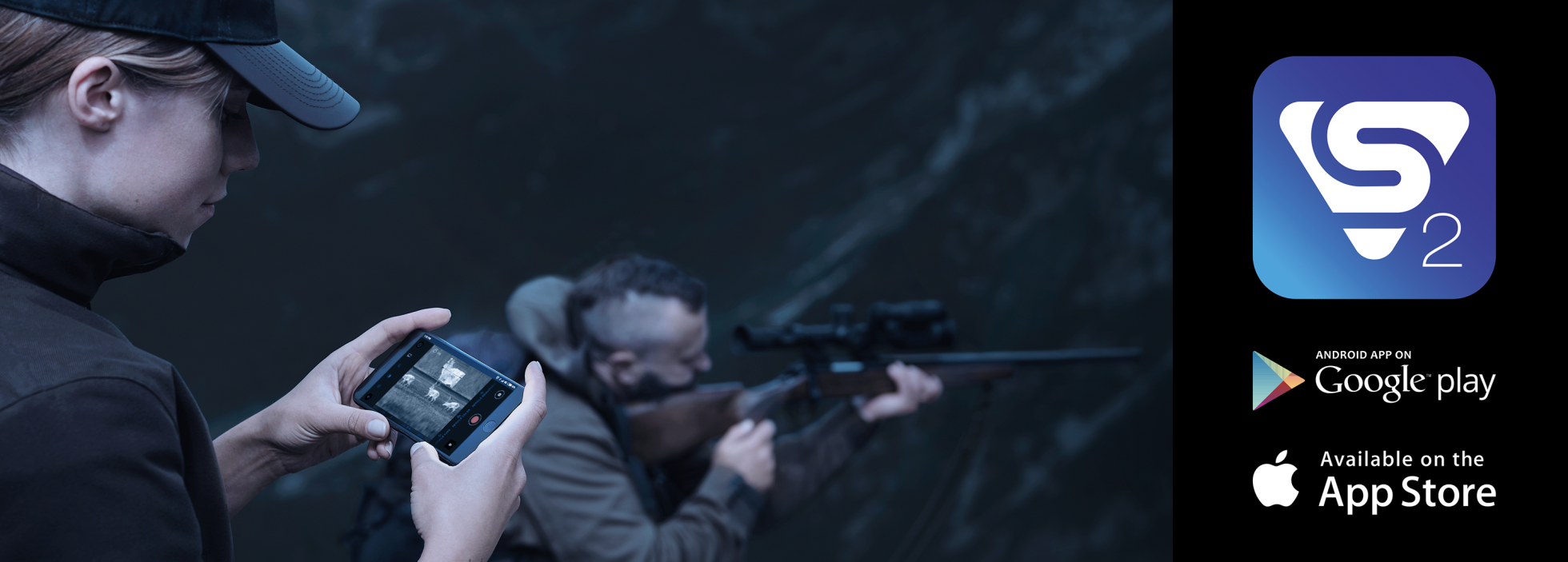
Forward S devices support Stream Vision and Stream Vision 2 mobile apps that allow you to stream real-time image from your device to your smartphone or tablet via Wi-Fi.
We recommend using the latest version – Stream Vision 2.

You can find further guidelines on Stream Vision 2 here.
Download from Google Play
Download from App Store
Find answers to frequently asked questions about using Stream Vision 2 here.

You can find further guidelines on Stream Vision here.
Download from Google Play
Download from App Store
Find answers to frequently asked questions about using Stream Vision here.
Maintenance
Technical Inspection
A check is recommended before each use of the device.
Check:
- External appearance (there should be no cracks on the housing).
- The state of the lenses of the objective, digital module eyepiece, monocular and IR-illuminator (there should be no cracks, grease spots, dirt or other residue). Wipe the exterior surfaces of metal and plastic parts free from dust, dirt and moisture with a soft, cotton cloth.
- The condition of the battery (whether it needs to be charged), electrical contacts on the battery and the IR illuminator, and connectors for their attachment to the device (there should be no sign of salts or oxidation).
- The controls should be in working order.
- The digital module should be properly and firmly attached to the optical device.
Technical Maintenance and Storage
Technical maintenance should be carried out at least twice a year and include the following steps:
- Wipe the external surfaces of metal and plastic parts free of dust and dirt with a cotton cloth. To avoid damage to the paint coating, do not use chemically active substances, solvents, etc.
- Clean the electric terminals of the Battery Pack and battery slot on the device using a non-greasy organic solvent.
- Check the glass surfaces of the eyepiece and the lens. If necessary, remove dust and sand from the lenses (preferably using a non-contact method). Cleaning of the external surfaces of the optics should be done with substances designed especially for this purpose.
- Always store the device in its carrying case, in a dry, well-ventilated space. It is essential during prolonged storage to remove the Battery Pack.
Power supply
Safety Measures
- Do not use the charger if it has been modified or damaged.
- Do not leave a battery unattended during charging.
- Do not leave the battery in a charger connected to the mains after charging is complete.
- The battery should be charged at a temperature between 0° C and +45° C, otherwise the battery life will be significantly reduced.
- Do not charge the battery immediately after bringing it from the cold into a warm atmosphere. Wait 30–40 minutes for the battery to warm up.
- Do not expose the battery to high temperatures or naked flame.
- Do not submerge the battery in water.
- The connecting of third-party devices with an energy consumption greater than permissible is not recommended.
- The battery is equipped with a short circuit protection system. However, situations that may lead to short circuiting should be avoided.
- Do not dismantle or deform the Battery Pack.
- Do not subject the Battery Pack to shocks or falls.
- When using the battery at negative temperatures, battery’s capacity decreases, this is normal and is not a defect.
- The batteries should be partially charged (50 to 80 %) for long-term storage.
- Store the battery out of the reach of children.
Battery Charging
The device is supplied with a rechargeable IPS7 Lithium-ion Battery Pack which allows the attachment to be used for up to 9 hours. Charge the battery before first use.
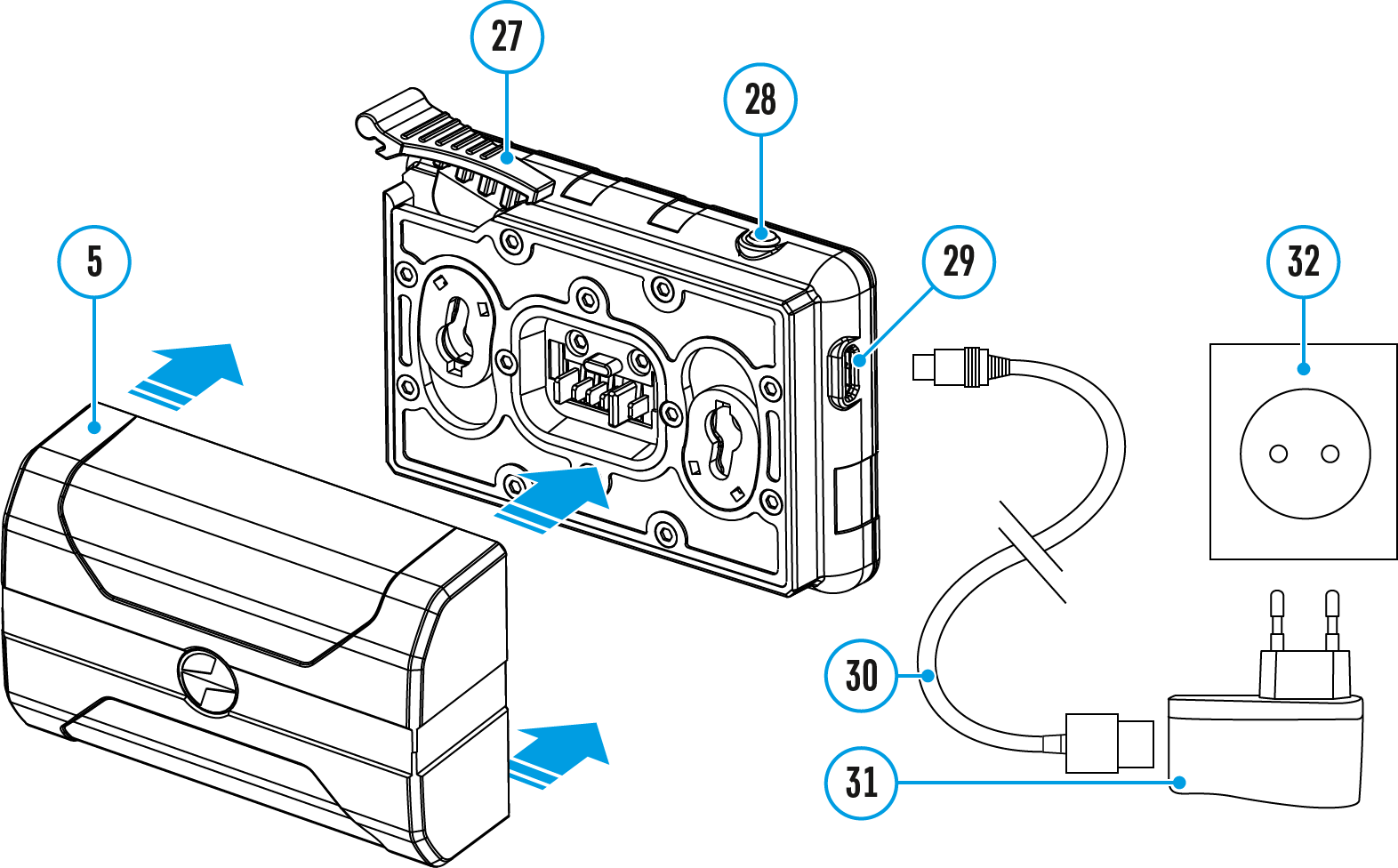
Charging
Step 1. Install the battery into the charger
- Raise the lever (27) of the charger.
- Install the Battery Pack (5) into the charger.
- Click the lever (27).
Step 2. Сheck the current battery level
- Upon installation, a green LED indicator (28) on the charger will start to glow and begin flashing:
– once if the battery charge ranges from 0% to 50%.
– twice if the battery charge ranges from 51% to 75%.
– three times if the battery charge ranges from 76% to 100%.
- When the indicator is continuously green, the battery is fully charged. Disconnect the charger from the mains and disconnect the battery from the charger.
- If the battery charger indicator is constantly red when the battery is inserted, the charge level is probably below the permissible level (the battery has been in a discharged state for a long period of time). Leave the battery in the charger for a long period of time (up to several hours), then remove and reinsert.
- If the indicator begins to flash green, the battery is good.
- If it continues to show red, the battery is defective. Do not use this battery!
The LED indicator (28) will display the battery charge status:
| LED Indicator (28) | Battery Charge Status |
| Battery is empty | |
| Battery is full |
Step 3. Сonnect the charger to the mains supply
- Attach the microUSB plug of the USB cable (30) to the microUSB connector (29) on the charger.
- Connect the USB plug on the cable (30) to the power adapter (31).
- Plug the power adapter (31) into a 100-240V (32) socket.
- When the indicator (28) is continuously green, the battery is fully charged. Disconnect the charger from the mains.
Battery Installation
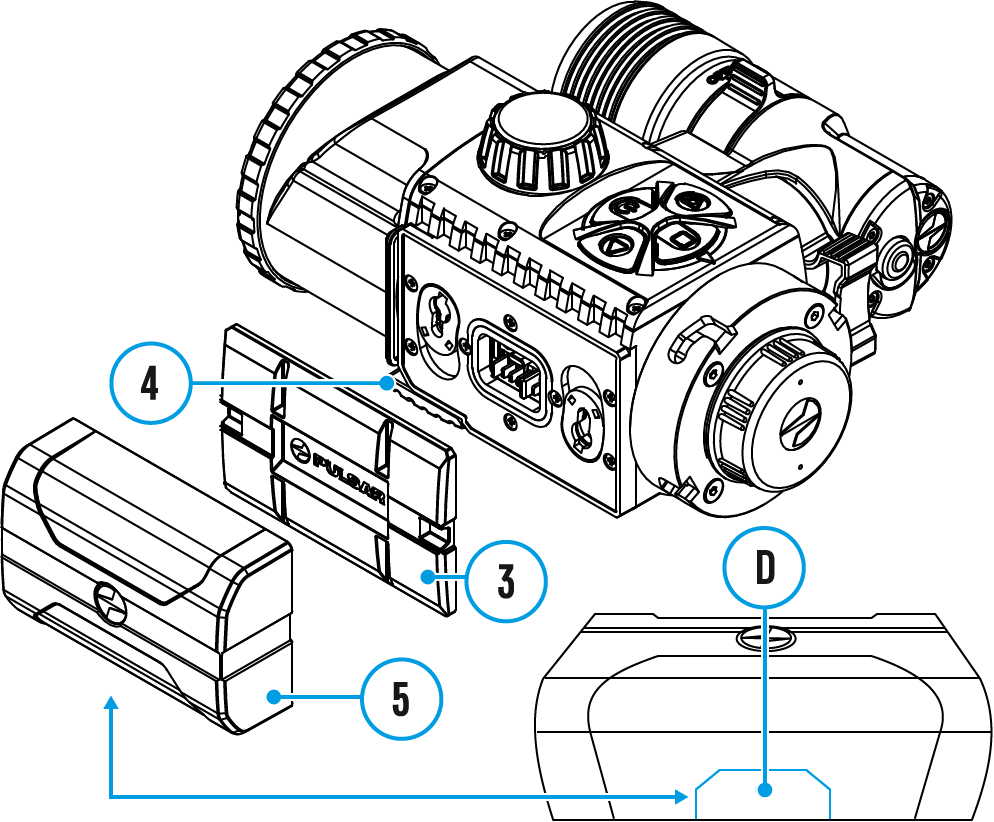
- Lower the lever (4).
- Remove the protective cover of the battery compartment (3).
- Insert the battery (5) into the slot designed for it on the device body so that the element (D) is pointing downwards.
- Lock the battery in place by raising the lever (4).
External Power Supply
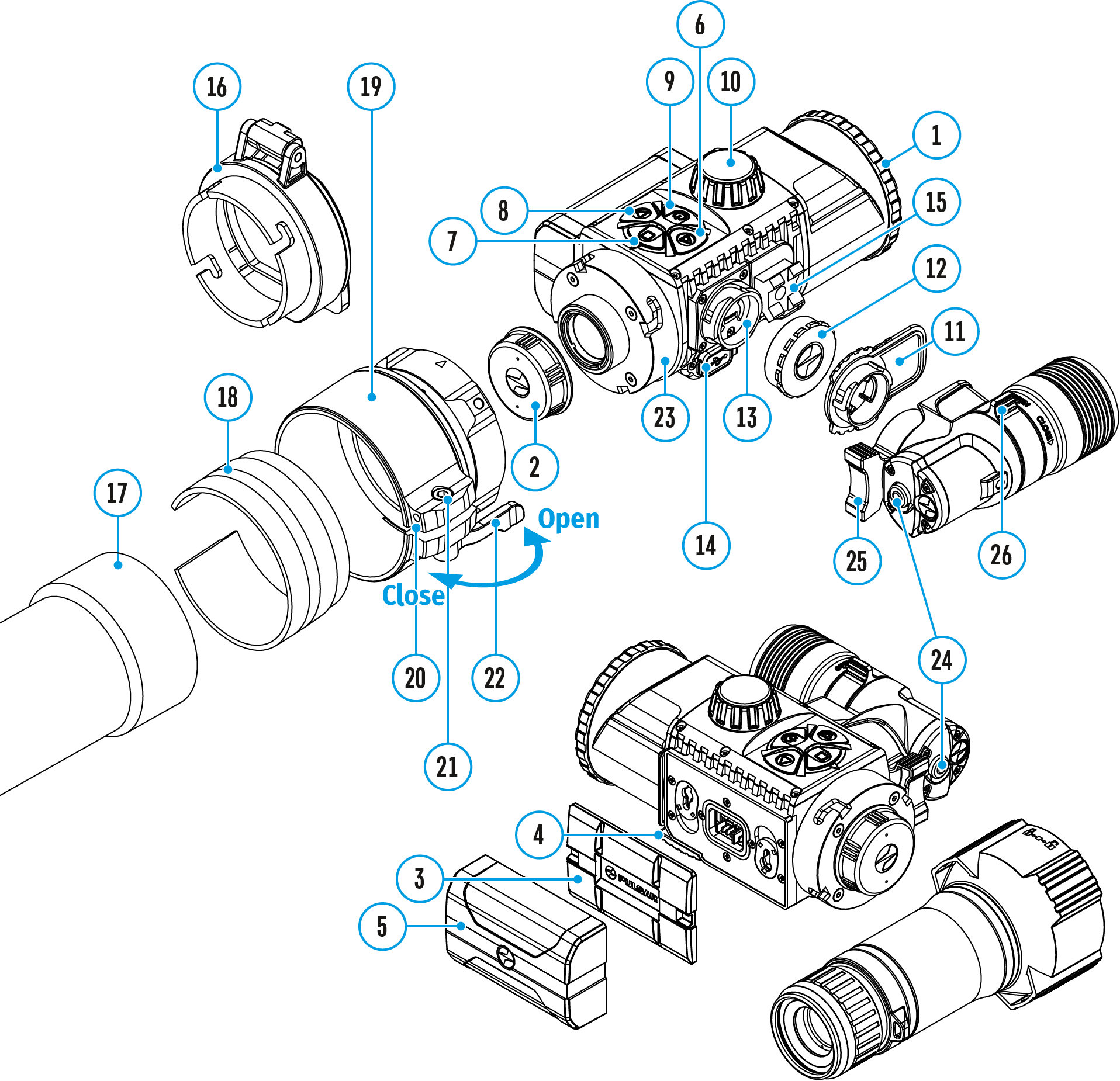
External power is supplied from an external source, such as a 5V Power Bank.
- Attach the external power source to the USB connector (14) on the device.
- The device will switch to operation from the external power supply, while the IPS7 battery will be gradually recharged.
- A battery icon
 will appear on the display showing charge level as a percentage.
will appear on the display showing charge level as a percentage. - If the device is connected to a computer, network adapter or power bank that does not conform to the BC1.0 battery charger standard, an IPS7 battery will not begin charging: the external power icon only will be displayed
 .
. - If the device is operated from an external power source and the IPS7 battery is not connected, an icon is displayed
 .
. - Once the external power source is disconnected, the adapter will begin functioning on battery power.
Attention! Charging Power Bank IPS7 batteries at air temperatures below 0 °C can result in reduced battery life. When using external power, connect Power Bank to the switched-on device, which have worked for several minutes.
Troubleshooting
For technical support please contact support@pulsar-vision.com.
Answers to frequently asked questions about the devices can also be found in the FAQ section.
The device does not turn on
Possible cause
The battery is completely discharged.
Solution
Charge the battery.
Device malfunction
Solution
In case of any malfunctions during operation, try resetting the device by long pressing the ON/OFF button for 10 seconds.
Image is too dark
Possible cause
Brightness or contrast level is too low.
Solution
Adjust the brightness or contrast in the Quick Menu.
The device does not operate from an external power source
Possible cause
The USB cable is damaged.
Solution
Replace the USB cable.
Possible cause
The external power supply is discharged.
Solution
Charge the external power supply (if necessary).
Color bars appear on the display or the image disappears
Possible cause
The device was exposed to static charges during operation.
Solution
When the exposure to static charges is over, the device may either reboot automatically or require to be switched off and on again.
Fuzzy image of object
Possible cause
Dust or condensation on the interior or exterior optical surfaces of the lens.
Solution
Wipe the exterior optical surfaces with a soft cotton cloth. Dry it. Let it stand for 4 hours in a warm room.
Possible cause
The lens will not focus.
Solution
Adjust the sharpness by rotating the lens adjuster.
Smartphone or tablet cannot be connected to the device
Possible cause
The device password has been changed.
Solution
Delete the network and connect again using the password saved in the device.
Possible cause
The device is in an area with too many Wi-Fi networks that may be causing signal interference.
There is a strong source of electromagnetic interference nearby.
Solution
To ensure a stable Wi-Fi connection, relocate the device to an area with fewer or no Wi-Fi networks.
Make sure there are no sources of electromagnetic interference nearby (working motors, transformers, etc.).
More information on solving problems with connection by following the links: Stream Vision FAQ, Stream Vision 2 FAQ.
The display is not centred
Possible cause
The position of the digital module on the daylight optical device requires adjusting.
Solution
Remove the adapter and set the display to the center of the field of vision (see section Installing Digital Module on the Optical Device).
The device does not focus
Possible cause
Incorrect setting.
Solution
Adjust the device in accordance with section Powering on and Image Setting. Check the outer surfaces of the lens and eyepiece; where necessary, wipe them free from dust, condensate, frost, etc. In cold weather, you can use special anti-fogging coatings (as, for example, for corrective glasses).
The digital module slides off the daylight optical device
Possible cause
The adapter insufficiently clamped.
Unsuitable insert selected.
Solution
Select a suitable insert and clamp the adapter as recommended (see the section Installing Digital Module on the Optical Device).
Missing or interrupted broadcasting via Wi-Fi
Possible cause
The smartphone or tablet is beyond reliable Wi-Fi range. There are obstacles between the device and the signal receiver (e.g. concrete walls).
Solution
Move the devices in line-of-sight and within range of the Wi-Fi signal.
More information on solving problems with connection by following the links: Stream Vision FAQ, Stream Vision 2 FAQ.
Cannot open the adapter clamp
Possible cause
Unsuitable insert selected.
Solution
Select a suitable insert.
Check for a gap between the lips of the adapter.
Remote control does not work
Possible cause
The Bluetooth module is not turned on.
Solution
Turn on the Bluetooth module according to the instructions (see the Bluetooth section).
Possible cause
The Remote control is not activated.
Solution
Activate the remote control according to instructions (see the Remote Control Activation section).
Possible cause
The Remote Control is out of range of the device.
Solution
Return to the device coverage area.
Possible cause
Remote control battery low.
Solution
Install a new CR2032 battery as follows: unscrew the screws on the rear cover of the Remote Control, remove the cover, install a new battery, and screw the cover with screws.
Poor image quality / Reduced detection distance
Possible cause
These problems may occur during observation in adverse weather conditions (snow, rain, fog, etc.).
Legal Compliances and Disclaimers
Attention! Forward digital night vision devices require a license if exported outside your country.
Electromagnetic compatibility. This product complies with the requirements of European standard EN 55032: 2015, Class A.
Caution: Operating this product in a residential area may cause radio interference.
Updates of the Product. The manufacturer reserves the right at any time, without mandatory prior notice to the Customer, to make changes to the package contents (subject to the applicable laws, if any), design and characteristics that do not impair the quality of the Product.
Repair. Repair of the product is available within 5 years after purchase of the product.
Limitation of Liability. Subject to mandatory applicable laws and regulations: manufacturer will not be liable for any claims, actions, suits, proceedings, costs, expenses, damages or liabilities (if any), arising out of the use of this product. Operation and use of the product are the sole responsibility of the Customer. Manufacturer’s sole undertaking is limited to providing the product(s) and related services in accordance with the terms and conditions of concluded transactions, including provisions established in warranty. The provision of products sold and services performed by Manufacturer to the Customer shall not be interpreted, construed, or regarded, either expressly or implied, as being for the benefit of or creating any obligation toward any third party (other than Distributor, Dealer, Buyer). Manufacturer’s liability hereunder for damages, regardless of the form or action, shall not exceed the fees or other charges paid to Manufacturer for the product(s) and/or service(s).
MANUFACTURER WILL NOT BE LIABLE FOR LOST REVENUES OR INDIRECT, SPECIAL, INCIDENTAL, CONSEQUENTIAL, EXEMPLARY, OR PUNITIVE DAMAGES, EVEN IF THE MANUFACTURER KNEW OR SHOULD HAVE KNOWN THAT SUCH DAMAGES WERE POSSIBLE AND EVEN IF DIRECT DAMAGES DO NOT SATISFY A REMEDY.
